#either during when the film was being animated or storyboarded
Text
Big Jack Horner is just Handsome Jack without a reason to be evil, no no, hear me out, here are the similarities between them. Warning, some spoilers ahead, very little but they are still there.
1. Both were funny.
2. Both were unapologetically evil.
3. Both owned high profile corporations and are immensely wealthy.
4. Both wanted to take control of an extremely powerful thing within the world.
5. Both hired mercenaries which ultimately were the cause of their downfall.
6. Both didn't believe they really deserved their defeat.
7. Both nearly got what they wanted and then lost it at the very end, they were about to win, then lost.
8. Both kinda had a good life before they went evil.
9. Both used any means necessary to get what they wanted to achieve their goals.
10. Death is what got them in the end.
11. Both sacrificed everything to get to the end and again, it's what killed em.
12. Both are a case of enjoyable villainy.
13. Both actually had fucking personality to them other than the 98% of other villains in media and gaming.
14. Heehoo pettiness go brrrrr. (Both were incredibly petty.)
15. Everything was personal to them.
16. Both owned unicorns... Sort of..... (Handsome Jack actually took care of his, Butt Stallion supremacy. Spoilers right here for 'Puss In Boots: Last Wish':Jack Horner cut the horns off of his, the horses driving the carriage of the baker's dozen are actually unicorns with their horns filed off. Look closely at that scene.)
17. Both were incredibly childish. (Refer to 15, 14, and 6.)
18. Both are called Jack.
19. Both are narcissistic as hell. (Refer to some other points)
20. Both are people who you never wanna piss off. (Refer, again, to 15 and 14. Handsome Jack make sure your head is on a stick or a silver platter, scoop something out your eyeballs with a spoon, or will show you the difference between strangling and choking. Jack Horner will also make sure your head is his, or use one of his magical items to "teach you a lesson")
21. How they both talk.
22. Both have not a single further care for another's life and just want more and more money and more and more power. (Well Handsome Jack cared about Angel, and his body doubles but not nearly enough his body doubles to trust them with certain shit.)
23. Both final battle arena's looked fucking sick.
That is all I can say ATM.
#borderlands#puss in boots#the last wish#they are nearly the fucking same#just trust me on this ok?#big jack horner#handsome jack#similarities#i wouldnt be surprised if some of the creative team for puss in boots played through through the borderlands series#either during when the film was being animated or storyboarded#or like in the past so they gave heaps of ideas
15 notes
·
View notes
Text
Evil thoughts and headcanons about benny and gcbc below
Benny is mad-scientist-adjacent in my mind. He’s almost one of those but hes an engineer instead. Still a freak.
Benny has facial hair. its in the storyboards and I cling to it like a koala to a tree during a forest fire
Benny IS short but he floats to peoples height so most don’t even notice
Old ass men. Benny would be born sometime before the 80s so he could actually grow up during that time! 1970 something.
For that matter, GCBC is also old as hell. Similar age to benny but he did not age anywhere near as well 😭😭 UGLY!
Benny and GCBC play fight like dogs.
Benny is NOT SKINNY!! this man eats ice cream every day he would not be skinny! no!
And for that matter, GCBC isn’t skinny either. Fat GCBC or death!
Hard of hearing benny. He works with spaceships those things are loud!
I dont think benny would care about pronouns. I usually use he/him for benny but i really dont think hed have a preference like everyone calls him he/him so he just goes with it.
On the other clawhand, GCBC is WOKE!!! He/it good cop he/she bad cop, collectively he/they because they are literally TWO GUYS!!!
More lgbt stuff. I think Gay Cop Bisexual Cop is funny to say so i go with it for that reason. Benny is probably also gay HE LOOKS GAY!
Good cop probably likes to go to the library. He just looks like he does. Round glasses. NERD!!
Benny is more evil than GCBC. The girls that get it get it and the girls that dont dont.
…I LOVE EVIL BENNY! i must continue. I feel like in the drafts for the lego movie benny was just absolutely deranged and they had to tone it down a bit for the final film but i love that he was such a freak! like what was his issue. all the removed stuff ive seen with benny was just him absolutely tweaking. AND HE KILLED GCBC he did that in the draft script and it was so awesome and he didnt even feel bad i love it!!
outside of like actual stuff from tlm i also think people infantilize benny a lot and its fun to just make him absolutely horrible to spite that.
also! Benny has brain damage the evil way… I project a lot for this cuz GIRL ME TOO! he has poor control over his own limbs and cant hold a train of thought very well and i dont want to continue cuz i takea lot of this specifically from my own experiences but those are just a couple things 🤔
I feel insane talking about this but i swear bad cop has an interest in cowboys. when emmet and lucy escape it seems like the first place she checks is the old west (i know its jsut movie logic… BUT STILL!), the folks in the old west recognize her theyre literally shaking cuz shes SCARY!! and she knows her way around the place pretty well which both of those are probably from her job but IDC!! now when she said “get off my train” WHAT IF what if she just felt protective over old west propertyy also in the behind the bricks video she mentions cowboys even though they were NOT that big of a part of the movie!! evil speculating on a fictional characters interests 😭😭😭
if they were birds gcbc would be an owl and benny would be a blue footed booby. also not about my main slop characters but related to bird legos, metalbeard would be an albatross.
continuing with owl cop, hes an owl because owls have large circular eyes, yet their eyes can also be very reflective, and they can twist their heads about.
if they were cats gcbc would be a tiger just so they could say “you bit the wrong tigers tail” and benny would be a serval
if they were dogs gcbc would be a german shepherd, obvious choice, and benny would be a schnauzer
if they were fish gcbc would be good cod bad cod just for the name and benny would be a pleco
when picking good cop up he would curl up like a happy kitty hed really like being picked up and when picking bad cop up he would scramble and claw at you in fear of falling (she is a frightened animal)
Good cop would watch kids cartoons in his free time, if he had any 💀
Good cop the type of guy to say “geeze louise”
Good cop the type of guy say “you wouldnt hit a guy with glasses would ya?”
Good cop the type of guy to say “ohh butterfingers” after dropping something
Good cop the type of guy to look for his tv remote and say “if i were the tv remote where would i be?”
Good cop the type of guy to close the fridge door with his hips
Good cop definitely has the urge to just collect trinkets but not the time nor money, maybe on weekends hed visit thrift shops just to get random stuff
Good cop and benny both seem like they chew on things when nervous
Both good cop and bad cop like the color pink but bad cop would be a bit more embarassed to share that. at home they definitely have pink blankets and pillows and all sorts of pink
Everyone is autistic if you think hard enough.
I love how everyone agrees that bad cop takes after his mother and good cop his father. Unanimous agreement ive never seen anyone headcanon it the other way
I say this as a joke but i dont have any way that i think gcbc wouldve come to be so its basically my headcanon even if its a joke. Good cop ate bad cop in the womb. Thats why theyre like that. And ma cop was terrified because she was set to have twins and only had one baby. 💀💀
Benny has definitely been hit with the “Hes smart but he doesnt apply himself” thing in the past.
GCBC is not a pale white man. Not happening. He would not do that!
If they participated in a chicken fight, gcbc would be on benny’s shoulders (as the cops cannot swim)
Good cop’s eyes are so big they squash his brain
15 notes
·
View notes
Text
SPOILER-FILLED REVIEW: Talking About That Evangelion 3.0+1.0 Ending

A note on safety: The following movie review undertook the strictest of safety procedures to watch the anime film in cinemas in Japan, including washing hands with disinfectant before and after, sitting in seats apart from others, going to a cinema outside of the busy metro area, and wearing a mask during the entire runtime of the movie. We strongly urge everyone to follow the recommended safety protocol in your country and always wear a mask when in public — not just for your sake, but everyone else’s as well.
For those who are outside of Japan and want to know how the latest (and final) Evangelion film stacks up, we have already published our completely spoiler-free review. For those that want to know more, please read on.
After the airing of the NHK documentary which followed Hideaki Anno and the four-year production of Evangelion: 3.0+1.0 Thrice Upon a Time, the unofficial “spoiler ban” was lifted by Studio Khara on March 22. This means, as much as Khara is concerned, we are free to discuss anything and everything Evangelion: 3.0+1.0, like how [omitted for spoilers] kills [spoilers] and LCL [spoilers].
Seriously though, if you don’t want to read any spoilers for Evangelion: 3.0+1.0, then leave. Immediately. Close the tab, don’t scroll down.
This is a warning.
I’m not kidding.

I’m putting an image here as a buffer. It's sweet right?

If you scroll past the next image you will be spoiled for everything in the film.
This is your last warning.
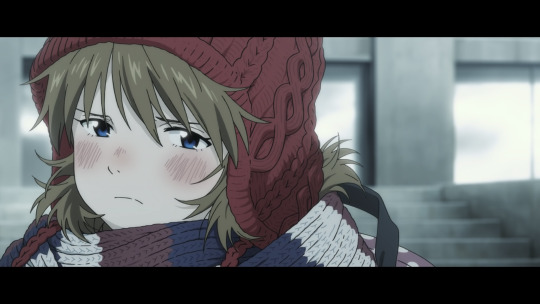
"Asuka" as a kid
Welcome to Evangelion: 3.0+1.0 Thrice Upon a Time where I may have lied in my previous review, cause things go tumbling down — but in a good way. You’ll have to forgive me if I don’t recall the exact right terminology here on out: between the Doors of Guf, the hundreds of Evangelion models and ships we see, and that ending, it’s hard to keep it all in one head. That’s why this film has four directors.
If you’re already here, you’ve probably read the synopsis going around the internet right now. Yes, it explains what happens on screen, but experiencing it is a different story. Evangelion 3.0+1.0 takes a lot of cues from The End of Evangelion in its final act, but prior to that it is mostly a story of growth for Shinji, where he rejects being depressed (after a heart to heart with black-suit Rei, who then turns into LCL), learns that things aren’t 100% his fault. Shinji goes on to tackle his source of depression head-on; owning up to his past mistakes and taking down his father, who is now literally just a vessel of his own desires.

Unholy Gendo
Something truly missing from Evangelion 3.0, and one of the reasons I loved Evangelion 2.22, was just the gang hanging out together and interacting with the — very scarred — world around them. That scar has vastly grown throughout the 14 years Shinji was missing from the actual 3rd impact (the one at the end of 2.22 was a “near-impact event”) which saw the world covered in the red haze we saw in 3.0. Luckily, WILLE has purification pods that keep the core-ification of the world at bay. We saw that being used in the 12-minute preview, but throughout the film, they’re used extensively to keep the Evangelion wandering the landscapes on the red earth away from the villages that are helping the WILLE cause. They need to get food from somewhere.
This is where we spend a lot of time learning how the characters from Shinji’s class all survived, got paired off, and that Asuka is staying (and is probably in love) with Kensuke. She confesses to Shinji that she loved him when they were kids, but 28-year-old Asuka can’t keep loving someone who hasn’t changed in 14 years. Shinji does accept the confession, saying to her that he loved her too, and she turns into LCL — though that’s in the Anti-Universe and after Asuka meets the “original” Asuka (I’ll get into that). As I said, it’s The End of Evangelion 2.0.
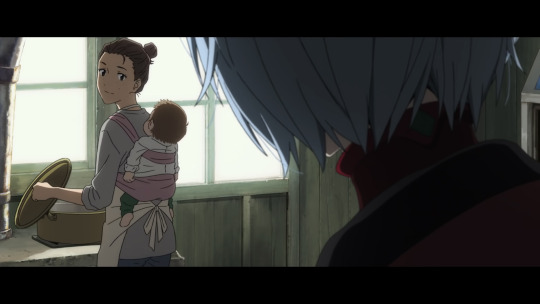
Rei discovering herself in the village
One of the nicest parts of the film is black-suit Rei discovering human emotion and society in the village. Being a clone that likely spent all of her time locked in her room (and without the love of the now inhuman Gendo, which original Rei got), it was unlikely that she learned anything that makes humans human. The concept of “hello” and babies from Toji and Hikari confuses her as she finds a place herself in this village. Admittedly, it was sad to see her go and turn into LCL (from a lack of LCL exposure), but serving as the catalyst for Shinji to get over himself and face his demons was worth it … I guess?
After this, Shinji grows up. Even Mari on a re-introductory sniff claims as much. During his time in the village, he discovers how the settlement stays afloat and that the 14-year-old son of Misato and Kaji (the latter perished in the real 3rd impact) helps keep the village alive. A picture of Shinji and Kaji Jr. helps warm Misato’s chilled heart and gives her the confidence to let Shinji pilot Unit 01 again, much to the disdain of multiple members of the WILLE crew.
All of this is nice. Unlike the despair and hopelessness felt in 3.0, the entire first three parts of the film are uplifting and bring moments of joy. Seeing black-suit Rei smile as she came to terms with herself was just utterly beautiful.
Then Shinji decides to get in the robot.

This is where I’m going to get into the Hideaki Anno talk, because this film, as well as the rest of the anime versions of the Evangelion franchise up to this point, is basically just a self-examination of the man’s mental state. In the spoiler-free review, I called Evangelion: 3.0+1.0 the antithesis of Evangelion: 3.0. And that’s true, but it is also an antithesis to The End of Evangelion: A rejection of the depression Anno felt while creating the 20-plus-year-old film. There’s no doubt in my mind that the journey of Shinji through these Rebuild films is the journey of Anno creating Evangelion, with 3.0 being the lowest point.
But this isn’t just felt in the story of 3.0+1.0, it’s also felt in the way it was presented. The entire final act of the film is basically a happier version of the “tumbling down” scene from The End of Evangelion, just with some more interesting aspects to it along with some inventive filmmaking — including making Lillith’s face live-action. That was haunting.
This includes the above scene, which got a lot of flak on social media for being very poorly animated when it appeared in a trailer. Even I was confused over the inclusion of such poor animation in what is one of the most hyped anime films of all time. Funnily enough, it was Anno trolling. The scene comes from the ending, where the two Eva’s fight through the history of Evangelion, with this scene either representing a testing stage for CGI or one of the many Evangelion video games. The poor animation makes sense in the film … mostly.
Over multiple film-like sets, the two Evangelions duke it out — one with Shinji, the other Gendo — over their ideals. This takes them to Misato’s apartment, the school, and even where Pen-Pen (or his offspring, I don’t know how long Penguins live) resides in 3.0+1.0. Before cutting to each of the different scenes, an Eva smashes through the set wall and onto a production stage.
I also said in the spoiler-free review that Anno “takes everything he knows about animation and filmmaking to deliver the perfect end to Evangelion,” and it shows when you see the (animated) production stage filled with props, miniature cities, and controls that you’d probably see on a production stage for a live-action Evangelion. Again though, this part is animated.

Mari at the End
The surrealness doesn’t end here. When Shinji “wins” and chooses to reset the world without Evangelion, the animation breaks. Shinji devolves into key animation, then layouts, then into a storyboard, which is then broken by Mari bringing color back into Shinji’s world on that beach. No “how disgusting” here, only happiness.
The film ends with an adult Mari and an adult Shinji at Ube Station. As the music of Hikaru Utada’s “One Last Kiss” swelled up through the speakers, the animated backgrounds slowly transitioned into a live-action drone shot of the area surrounding the hometown of Hideaki Anno.

A poster for Evangelion: 3.0+1.0 showing Shinji on the tracks outside Ube Station, which I discussed when the poster was first released.
This is how I know Hideaki Anno is done with Evangelion. While yes, he has said he is done and feels no personal connection to the franchise anymore, the end of the film is a deeply personal one that clearly shows the anime creator cares about his creation and is now happy enough to see leave home and become its own thing — if anyone else chooses to pick it up.
Shin Evangelion (the Japanese name for the film) is the true form of Evangelion that Anno set out to create over 25 years ago. While it wouldn’t have looked anything like it does now, the emotion poured into one of the longest animated films ever made makes that point as clear as the bright blue sea.
Some other various interesting spoiler points:
I’m not sure if character designer Yoshiyuki Sadamoto was lying about him not knowing Mari’s story and just making that one-shot chapter of the Evangelion manga on a whim or whether Anno took what Sadamoto wrote and expanded on it, cause Mari was right there in school with Gendo and Yui exactly as the chapter laid it out. Unless she’s also a clone...
There’s a really good shot of CG Asuka trying to force-feed Shinji, which was a direct evolution from this test footage back in 2018.
On the topic of Asuka, she had a small version of a purification pod in her eye that, when opened, unleashed an angel, and in turn let her meet her “original.” It’s not explained whether the original is Langley Soryu from the TV anime series or not.
Also, she’s a clone, like Rei and Kaworu as part of the “Shikinami” series. Interestingly, Mari Makinami also has “nami” in her name...
Ritsuko did nothing but shoot Gendo, mimicking the scene from The End of Evangelion. The shot was as useless as her character arc in the Rebuild films.
This film has to be set in at least the third continuity of Evangelion, as the TV series is directly referenced in the production stage and thrice does mean three...
Sakura is one of the most grounded characters in the film, with her asking the true question of “why the heck are you letting him in ANOTHER Evangelion?!” Let’s hope the live-action world she is now in is good to her.

Evangelion: 3.0+1.0 Thrice Upon a Time is currently showing in theaters across Japan, there’s no word on an international release at this stage.

Daryl Harding is a Japan Correspondent for Crunchyroll News. He also runs a YouTube channel about Japan stuff called TheDoctorDazza, tweets at @DoctorDazza, and posts photos of his travels on Instagram.
Do you love writing? Do you love anime? If you have an idea for a features story, pitch it to Crunchyroll Features.
By: Daryl Harding
41 notes
·
View notes
Text
Making Movies and Storytelling
an insightful blog on home movies and artistic storytelling by rhett rhodes

cyanide and silicone - crawl space music video, directed by me!
recently i had the idea to write and direct a music video to one of our songs from our new album Tag The Tongue 2: Taggin’ Out. i went through all twenty three songs trying to decide on a song i’d like to make a video to before i finally decided on track number four, ‘crawl space’.

i am a filmmaker at heart, that’s honestly all that courses through my veins is story telling; narrative, images, or no narrative at all, i just like the idea of telling or showing some kind of story.
i believe i started production on crawl space on november 22. i began creating the mask out of cardboard, construction paper, tape and strings that night and began filming the next day when the glue had dried and the homemade mask was ready to go. i wanted this to be an old looking video, like a b-movie from 1941.
i decided to film this video like a real movie, and map out each scene as precisely as needed. so the first couple of scenes the rabbit does basic things, like wonder around his home, observe his cats and dogs, and stand under house lamps all the while being accompanied by another rabbit, which is presumed to be imaginary.
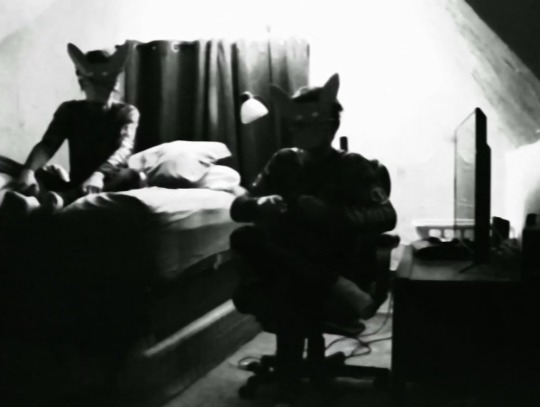
as the video progresses the rabbits behavior intensifies, and begins to act more nihilistic and psychotic. scene five depicts the rabbit pouring blood into a ziploc baggie labeled “zach”. giving us a hint that the rabbit either killed zach from the previous albums or is simply just harvesting his blood. either way, this is a easter egg in the lore from the previous songs and albums that zach is most likely really dead.
either way, he freezes the contents of the baggie and creates a frozen drink for his animals. the rabbits also watch tv and can’t get the volume to work on an old pontiac advertisement starring Leo Gorcey (whose movies in the 40s inspired this whole thing. that part of the music video is my favorite part. just a little gag to add to the story, add a comedy element.
especially the ending right after that. during the video we see the rabbit at his desk writing something in his notebook, and at the end it’s revealed that he wrote the word “RABBIT”. then we see the body of one of the rabbits walk in front of the television screen and unzip it’s pants. it then cuts to a white screen displaying the name “crawl space” in 1940s lettering.
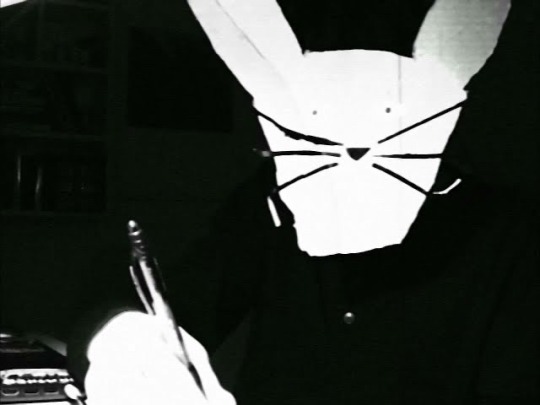

so, what’s the story? the story is basically that this is just part of the lore to the entire albums. it tells a part of the storyline that we haven’t heard yet across the 5 cyanide and silicone story albums. it’s ambiguous, and could be interpreted into song later. as for now, it’s just a part of the rabbits daily life. live, watch tv, and commit heinous acts on other life.
pretty weird. i promise no drugs were involved in the making of any of this, including the 6 + year storyline we’ve been creating thus far in the music. only now, we want to make short films and music videos as another way to continue on the story and lore without usage of particular songs. a song could be played over clips of a completely unrelated matter, but that unrelated matter still tells a part of this story.
youtube
so here’s the video! i wrote it, storyboarded it, did costumes, edited it, directed it, acted in it as the rabbits, and also made the beat, wrote the lyrics, mixed and mastered the entire song as well. a complete homemade project that i hope others can be inspired by! i love art, storytelling, and visual art and anyway i can do that, i definitely will.
i hope you like some of my first efforts!


#cyanide and silicone#tag the tongue 2: taggin’ out#blog post#blogger#text post#long read#music video#youtube videos#aesthetic videos#art project#art film#short film#white rabbit#rabbit#creepy#horror#horror movies#40s aesthetic#aesthetic#black and white#blog#a e s t h e t i c#music#rap music#horrorcore#weirdcore#spotify#old film#inspiring message#filmmaking
3 notes
·
View notes
Text
Reading and Response #3
Time and Motion
In all honesty. I found this chapter to be a complete slog to read through. I think this is because much of what was talked about, felt like a retreading of concepts and ideas I’m already familiar with. As someone whose main art background is in animation and storyboarding. Time and motion are everything in those two mediums. For example, when animating a character, just a couple of frames can completely change the feel or meaning of a movement. Does a slight pause show hesitation or assessment? Does a character move in big grand gestures or in a small subtle way? There is a reason timing and spacing is probably the most important and most difficult principle in animation. The use of time can either make a shot great or make it a complete dud.
Vanishing and Becoming
I would say that I agree with Cubitt on light and projection being the first art mediums. It’s is something that has always been with humanity. As he talks about during the essay it’s something that we have built up over the course of history. Where now in today’s society, it’s become one of if not the most prominent art forms in the world today. Everyone has seen a film at some point in their lives. It’s also interesting to think how what we see is only a representation of the object but not the actual object. What we see isn’t reality but a version of it. Also relating this idea to Plato’s The Cave was an interesting idea. Since that metaphor deals heavily with idea that what we see might only be a mere shadow of the actual world.
1 note
·
View note
Text
Year 1 Week 1
year 1
week 1
day 1
identity and position 5th october
let the tutors know if there are any problems
independent work and collaborative work
learning on studios
developing self directed practise and presentation skills
manage your time 7th december is the deadline meet the deadlines make sure your meet the deadline you have opportunities to succeed take pictures of everything and record the work and the processes of the ideas and work to be professionals know what your work is about
day 2
day 2 (online class) 1000-1245
so we were asked 3 questions:
1. is illustration? A form of art communicating a message or showing a visual idea , recording a plant/ form of life in the wild recording an event unfolding before you (I remember seeing a painting on my trip to Russia of a massacre bloody Sunday) in fact in one could say Communist Russia and Germany when run by Adolf Hitler used art and radio to push their ideology and communicate a positive facade of their horrid plans for their respective countries.Especially illustration in newspapers which at the time people were an important part in human life especially in Europe.Your everyday reliant on newspapers to tell them the truth new shops to check out new restaurants to visit new products and services to buy,2. what is its purpose?- One's expression to bring joy or to just feel and create sometimes there is no reason you just felt like making something - to model or demonstrate a service ( a digital animated character walking) a potential product (iPhone 11pro), building,space,enviroment,scene,character etc.- to communicate ideas,views,opinions,thoughts,irony e.g political cartoons in british newspapers or films - to entertain / divert the masses - film/comic strips in newspapers or online,books,animation,games etc.- to make people think - painting or film or anything Banksy does his instagram is awesome 3. what can illustration do?anything literally it can impact all industries: helping pharmaceuticals and chemists on how to perform an experiment or how the lab should look the possibilities are endless- restaurant menus- visual ideas - storyboards for tv and films et design etc.- product design cars electric devices- where the fire exit signs- online training videos for companies animation for scenarios how to videos - a brand logo apple,The Walt Disney Company, the vue cinema logo etc.From wikipedia - ' Contemporary illustration uses a wide range of styles and techniques, including drawing, painting, printmaking, collage, montage, digital design, multimedia, 3D modelling. Depending on the purpose, illustration may be expressive, stylised, realistic or highly technical.Specialist areas include: Architectural illustration Archaeological illustration Botanical illustration Concept art Fashion illustration Information graphics Technical illustration Medical illustration Narrative illustration Picture books Scientific illustration' here are the groups i was in zoom group 5 answers :an interesting find i find whilst researching :/An illustration is a decoration, interpretation or visual explanation of a text, concept or process,[1] designed for integration in published media, such as posters, flyers, magazines, books, teaching materials, animations, video games and films. An illustration is typically created by an illustrator. Illustration also means providing an example; either in writing or in picture form.The origin of the word “illustration” is late Middle English (in the sense ‘illumination; spiritual or intellectual enlightenment’): via Old French from Latin illustratio (n-), from the verb illustrare'
research sites:https://en.wikipedia.org/wiki/Illustration#:~:text=An%20illustration%20is%20a%20decoration,typically%20created%20by%20an%20illustrator.
https://www.wordsense.eu/illustrare/
for me illustration is my expression whether via biro pen or watercolours etc. whatever medium this discipline can bring joy it can evoke an emotive memory it can inspire civilians to go to war and 'fight the huns' which many cartoons in newspapers did it during the first world war and second world wars.evoking a sense of comradery a call for heroes a call to 'do your bit' 'keep calm and carry on' and 'do your bit for the war effort'. illustration has the power to communicate an idea or various ideas therefore it has the ability to influence people and inspire and positive or negative reaction illustration and therefore art has power
...where do we get our info or inspo from?the internet - images,text,youtubecinema - filmstv- adverts games - ubisoft's assassin's creed 2,brotherhood
what are you inspired by in accordance to the senses?Sensory integration is the process by which we receive information through our senses, organize this information, and use it to participate in everyday activities.An example of sensory integration is: Baby smelling food as they bring it to their mouth Tasting the food Feeling the texture Determining what this food is and if they want more https://pathways.org/topics-of-development/sensory/You read that right! Most people think there are just 5 sense, but there are actually 7! So what are the 7 senses?How might we use these senses in art Sight (Vision) - light the effect of light,everything we see nature social media,traditional media fine art in newspapers, film,photography,books,cartoon,animals,water,rocks,buildings and products,food, clothes,people etc.
Hearing (Auditory) - hearing a problem and trying to figure out how to fix it,hearing sound and figuring how to visualize it or incorporate it
Smell (Olfactory) - thinking of a memory how one felt at a specific time and trying to encapsulate that feeling that emotions and expressing that emotion or how one feels before during and after a smell e.g the air during a hot salty windy day at bournemouth beach
Taste (Gustatory) - memories,good food the feeling of gooey melting chocolate in my mouth trés delicieux!
Demonstrate that in a physical tangible state and or image whether it be traditional analogue on paper perhaps a 3D digital
Touch (Tactile) - textures and grains and movements of a rock of thing feathers and feeling and recreating that or recording it perhaps Vestibular (Movement) - the movement and balance sense, which gives us information about where our head and body are in space. Helps us stay upright when we sit, stand, and walk. - Dance the feeling of a wave hitting the rocks or water against you
Proprioception (Body Position): the body awareness sense, which tells us where our body parts are relative to each other. It also gives us information about how much force to use, allowing us to do something like crack an egg while not crushing the egg in our hands. - inspire to create an animation or a short film of various movements and how the character walks runs etc. various body movement prior to filming character development *FILM/TV/THEATRE mechanical horse like in war horse etc.
* Emotion and feeling - making people feel a different emotion or various emotions feeling empathy or anger making people feel inspired to better society
skills that I am confident in : paying Attention to detail
- Interpersonal and Communication Skills
- Teamwork and Multi-tasking
- Adobe Photoshop, Illustrator, Lightroom, InDesign, After Effects, Premier Pro and Capture One 10- Drawing- Painting- Illustration- Calligraphy- film and digital Photography as well as editing
I care about and hope for :
Our World:- Education for everyone - ignorance is not bliss but a trap to be manipulated and controlled.Critical thinking discussions and emotional and mental growth is a positive thing is is an asset to society.Every human being able to have a full education for them and their needs if they are great at art and history they should not be shamed for not doing good in science!The current Prussian educational system is not helping everyone excel in the subjects they are good at - it was meant for military education in the ancient world after all however we need an improvement.Especially on the teachers hired and trained.Some countries are allegedly failing students just so that they can work in a specific manual labour industries when the kids are intelligent enough to be doctors and scientists they are purposefully failed and told to smash rocks or other manual labour jobs.
I care about the safety and innocence of the next generation globally for kids to be safe from men and woman who want to use them for their own benefit e.g greedy parents,predators,human traffickers and cult leaders
The ending of homeless (people being able to work and have their own home in the UK especially in London)
The end of human trafficking one human forcing another human being to do something for free and forcibly take away their own freedom their God given free will that is not okay to me that will never be okay we are all priceless.
1 note
·
View note
Text
Masters Project Update
It has been a long time since I have posted on here. Unfortunately due to the current worldwide pandemic that has been going on for the last 3-4 months and the fact that I am a key worker working in the healthcare sector I have been unable to devote much time to my university work and have made very little progress since the university closed and lockdown began.
Having this time away from my project has given me time to reflect on what I was trying to achieve with my series and what I wanted to have as a final product. Due to the nature of the job that I do (many repetitive tasks that don’t require much thinking) I was able to devote a lot of time to fleshing out the story of my series and do a deep dive into my characters pasts and personalities.
I arrived at a place with my main characters for my series which I was really happy with and began writing out the main points for each episode, explaining what each character would do where they would begin, where they would end up and whether they would change or develop along the way.
It was during this time that I began noticing issues with my story, I would write an arc for one character that felt right but wouldn’t allow other characters stories to shine.I found myself constantly rewriting my side characters stories trying to contort them to find into my main characters story.
After many failed attempt to rewrite the side characters stories I opted to remove one of the main characters and put him aside to be used in another series that I was planning to develop after I have finished university. I then sat down and rewrote the main characters story, making the series completely about his journey.
But again I began to hit road blocks, character choices didn’t seem to make sense, things appeared to happen just because the story needed them to to move forward. I began spiraling and spiraling trying to make this story work when in the back of my mind I already knew that it just wasn’t going to come together, and if it did, it wouldn’t be a series that anyone other than me would be interested in watching.
So I tried to take my mind off of my series for a few days, hoping that if I did, some inspiration might present itself. During this time I began coming up with other small ideas for animations I would like to produce when I have free time in the future. Small skits, animating various funny scenarios that have occurred either in my life or someone I knows. I even made a plan of starting to animate 1 second a day for an entire year, similar the bothers McLoed who created 365, a short video based around the same premise of animating 1 second a day.
While taking this break from my series I began looking through old notes I have written and scrips that I had started and never finished. Most of what I found was so incomplete it threatened to send me into another spiral. But there was one script that stuck out from all of the others. It was a short film I had written one night while I was walking home from a night at one of my friends from work house, The wak took me around 45-50 minutes so I had a lot of time to think and something had sparked an idea in my head. Something I saw or something I had heard had set this idea in motion and I had managed to write a huge amount down by the time I had gotten home.
After I found this script I began rewriting it trying to picture how I wanted it to look, the art style and the way I would go about animating it. It didn’t take me long before I had written a 12 page script that I knew I could add to if needed or would be fine the way it was. I save the document and put it to one side thinking that now I had completed a project it might allow me to figure out the issues with my series. So I began working my way through my series story again trying to figure out where it was going and how to make it flow without it feeling as if it was being pushed along to reach a certain goal, I wanted it to feel organic.
But the more I worked on my series, the more my short film idea would crop up in the back of my mind. I would sit down on a night when I had an hour to do some work and would find myself looking up different art styles or ways to frame shots for this short film that I wasn’t even making.
I finally gave in and with one of the few days I have had off work since lockdown began, I devoted a full day to researching and doing a script breakdown, began storyboarding and coming up with how the story would flow and how I would inter-cut the present day scenes with flashbacks and nightmare that the character would be having (This might seem confusing but I will be doing a post soon explaining the story). I found that I was enjoying working on the project infinitely more that I was enjoying working on my series. Every time I though of a new shot or a new layer to the story it was exciting, unlike working on my series where every time I had a new idea I dreaded having to go back and rewrite huge sections of the story to fit it in.
Long story shot I have decided to change my project Idea from creating a pitch bible for a series, along with an animated title sequence, a couple of animated scenes and possible a short trailer. To my new idea and produce a short film of around 5-7 minutes and an art book to show to process of the making of the film, including the research and the inspiration.
1 note
·
View note
Text
Death Note One-Shot Chapter Review
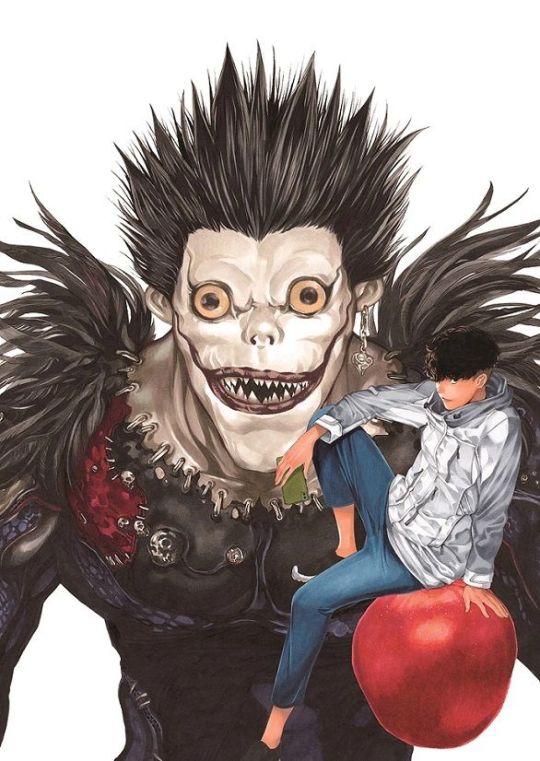
“AH! SHINIGAMI!” But in 2020!
By: Nay Holland
Death Note started off as a manga and anime series that joined others in its ilk during the 2000s renaissance. This was the time period that brought us many herald classics such as Naruto, Bleach, One Piece, Inuyasha, Full Metal Alchemist, and Gurren Lagann. I can spend the entire time naming at least ten other series that would either go on to have devoted fans over a decade later or continue in some form. Of course Naruto lives on through Boruto, rumors of a Bleach revival are on the way, and One Piece is, well, never ending at this point.
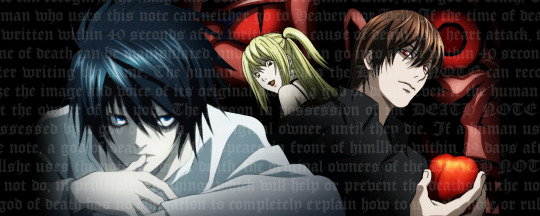
However, among the “Roaring 00s” of anime, Death Note always stood out to me. While I was invested in Naruto since middle school, I hadn’t touched Death Note until my high school years. During this time, the series was still popular, yet it always seemed overshadowed by the other bigger names. Despite this, it remains a huge hit in Japan with several live action movies, a prequel light novel, several dramas, and a TV series.
Of course, there was also the Netflix Original film which was an attempt to “Americanize” the series, for whatever reason. Back in 2017 it was a talking point, mostly how it didn’t live up to the source material presented. Nowadays, no one really talks about it and it is probably for the best.
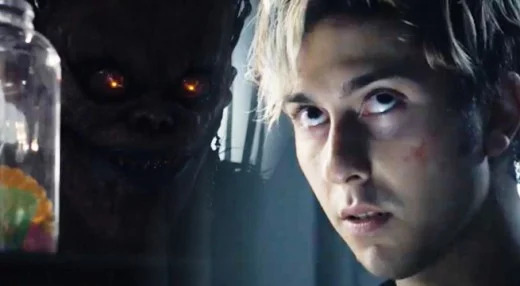
While Death Note is considered a cult classic in both the East and the West, it is no surprise that content is still being created to this day. The surprise factor stems from the unexpectant delivery of said content. On February 3rd 2020, the creators behind Death Note, author Tsugumi Ohba and artist Takeshi Obata, revisited the world that Kira left behind in a one-shot published by Viz Media.
While you don’t need to read the original manga to read the one-shot, the one-shot will assume you know the original source as many existing characters, themes, and events from the original manga are all featured within the chapter. That said, it will greatly enhance the experience if you know the source material. Past this point there will be spoilers on the original manga and the one-shot chapter as I’ll be referring to both.
This isn’t the first “one-shot” within the Death Note universe. The first official one-shot dates as far back as 2008, two years after the original series was completed. Set three years after Kira’s death, this one-shot focused on a new “Kira.” This “Kira” has access to the Death Note via a shinigami (who wasn’t Ryuk) and used it to murder those who had a low life expectancy. However, the new “L,” formerly known as Near, quickly shuts his antics down. The new “Kira” then uses the Death Note to kill himself and the shinigami retrieve the book.

Before we can discuss the latest one-shot, we first have to discuss Takeshi Obata’s art exhibit that was held in the Summer of 2019; Never Complete.
Never Complete was an art exhibit celebrating Obata’s thirty-years as a manga artist. Within the exhibit, many of his previous works from Hikaru no Go, Bakuman, Death Note, and the latest ongoing series, Platinum End were all on display.

Bonus content which included first drafts of illustrations, were also featured. Among the bonus content, the most peculiar one was a storyboard draft of the 87-page one-shot. The storyboard draft can be seen and read in almost its entirety on the official Shonen Jump Plus website. Six months later, we have an official release in both Japanese and English. The official English translation can be viewed here.
Our story begins right where the previous one-shot left off. The shinigami who wasn’t Ryuk, gives Ryuk back the Death Note, claiming he was unsuccessful while also giving him an apple as an offering. Being bored of the shinigami world as well as a craving for more apples, Ryuk sets off to see who could be the successor of the Death Note. If it entails free apples, Ryuk ain’t complaining.
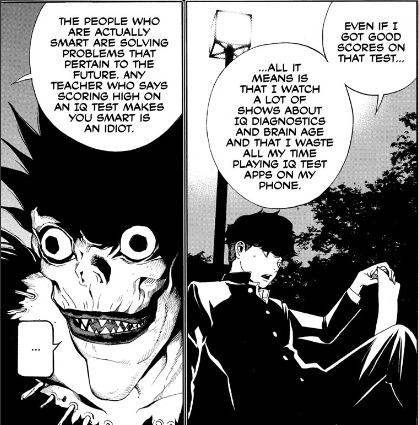
We then get to meet a young Minoru Tanaka, a middle schooler who is known for having the highest test grades in the region. When Ryuk introduces himself to Tanaka, the only thing Ryuk knows is that Tanaka is smart in school, comparing Minoru Tanaka to Light Yagami’s aptitude in school.
However, his actual grades are mediocre at best. This already contrasts Light who was a certified genius both in tests as well as grades. As Tanaka explains that his ability to score high on tests are dependent on his knowledge of IQ tests and quizzes, he bemoans that adults who see grades yet fail to see the bigger picture are no better.
As Tanaka holds the Death Note in his hand, all he knows is that it was once Kira’s. It is during this scene that we learn the state of Tokyo after Kira’s death, ten years later. Yagami’s legacy lives on as he is taught in schools around Tokyo. Tanaka exclaims that he was taught about him in Ethics class and in World History class, both of whom consider him to be an evil mass-murdering sociopath that placed Tokyo on the brink of destruction.

There’s just one problem with holding the single most powerful and dangerous weapon in the world. What good is a Death Note if you can’t even read its instructions?
While this wasn’t a problem for Light as he was a genius who understood fluent English and Japanese, here was a middle schooler who struggled with English. He asks Ryuk to translate the English into Japanese, just so that he can understand how to use it.
However, while not as academically bright as Light, Minoru is more logical with his approach. He understands how the Death Note was used in the past. The major difference between the past and the present are the increase in security measures to ensure a repeat of what happened doesn’t transpire again. When Ryuk asks if Minoru can use the Death Note the same way that Kira did, Minoru hesitates.
Knowing the state of Tokyo right now as well as knowing the history of Kira and the Death Note, he has no interest or intentions of using the Death Note for similar deeds. Here lies a normal child who excels at critical thinking who has the opportunity of a lifetime.
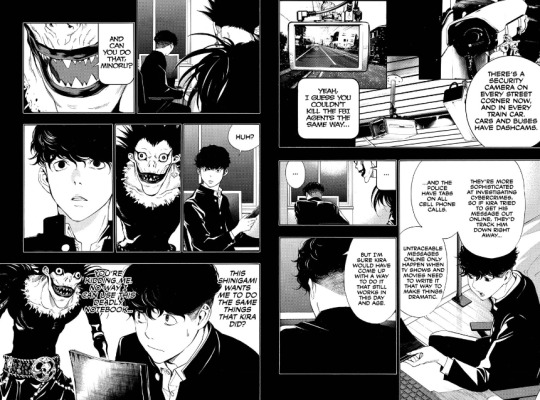
Those who don’t learn from history are doomed to repeat it. He also can’t risk the book falling into the hands of someone else who would use the book for the same reasons Kira did, or worse. So he does the one thing that he could do in this situation.
He buys himself two years of time. He tells Ryuk to come back to him in two years, while asking him two critical questions.
The first question he asks is if it was possible for those who touched the notebook to still see Ryuk. This would involve the former Investigation Team and Near, who brought Kira to justice.
The second question was how far can Ryuk move around without being close to Minoru. This comes into play two years later when Minoru decides to ultimately sell the Death Note.
That’s right. He sells the Death Note.
But not just to anyone, especially not via Craigslist either.
Conveniently, the TV broadcast station is close by Tanaka’s house. With a pen and paper he tells Ryuk to write a message that will incur interest without actually having to directly contact Tanaka himself. Since the net and all of its usage can be easily tracked, using the TV to broadcast the message provides a safe approach for Tanaka to cover his trail. Rather, you can’t cover a trail you never create.

Conversely, those who had seen Ryuk from ten years ago, were able to see Ryuk on television. This introduces several key characters from the original series into the one-shot. The first is Matsuda, who is every bit as hot headed and foolishly passionate in the present as he was in the past.
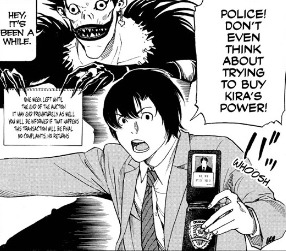
The second, is L.
Not the L we know, but, the current L. Near.
Fragments of the iconic “L vs Kira” fight start to show over the next few pages as the bids for the Death Note reaches into the trillions and L continuously wondering how things are playing out. He understands that the “Auction Kira” or “A-Kira” is playing a very cautious game, but fails to see the endgame.

As the bid for the Death Note reaches record highs, it is revealed that the two nations bidding for the Death Note are none other than…
...The United States of America…
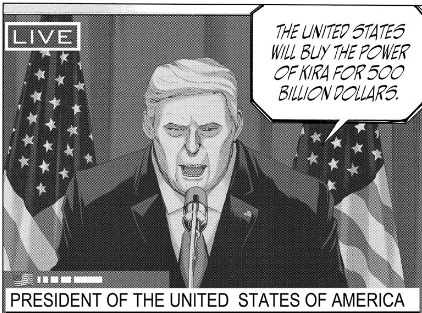
...And China….

Despite two of the largest world leaders in the hot seat bidding on the Death Note, Minoru is unphased. In the end, the USA wins the auction. At this point, Near awaits to figure out just how “A-Kira” is going to attain the money. Thinking this through, Minoru demands payment in such a way that it is almost impossible to be tracked down.
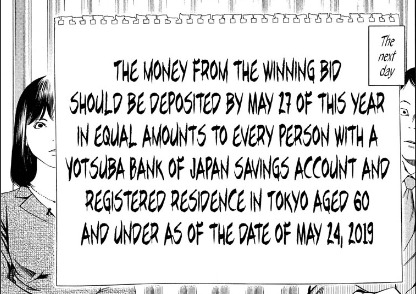
Within this time period, it is enough for Tanaka to relinquish ownership of the Death Note, forget he had it, and live a peaceful life along with millions of others in Japan. Given the circumstances and how millions will have access to such money, as well as the owner of the Death Note forgetting he had the Death Note, Near backs off, admitting defeat.

There is one fatal flaw to Tanaka’s entire plan and it was a flaw that would lead to his death.
Turns out Tanaka was so smart that not only did he outsmart the smartest human alive, but he also outsmarted the Shinigami King himself. Shortly before the Death Note was relinquished, the King ordered Ryuk to write a new rule within the Death Note. The rule being this.

With even the Shinigami King being upset that the Death Note was allowed to be sold to another, this new rule ensured that Tanaka was going to die a month from now. The president, however, chose to relinquish ownership, but declares that he has the power of Kira to herald his power over everyone else.
So, as stated in the new ruling of the Death Note, Tanaka’s name was written in Ryuk’s Death Note as soon as he received the money and the chapter ends on that note.

The first thing I want to mention is that Tanaka was too smart for his own good. Kira’s downfall was that his God complex forced him to become disillusioned. Tanaka’s downfall was the complete opposite. He felt his plan was entirely foolproof without taking into the variable of the shinigami lowballing him.
This reminded me of the time when Rem declared that she would kill Light if he ever caused the death or harm of Misa. At this point this was Light’s first interaction with another shinigami. Knowing who Rem was and the type of person she was, he was able to manipulate her to his livelihood by sacrificing herself. Tanaka never got to see the Shinigami King himself, and the King made sure of it.
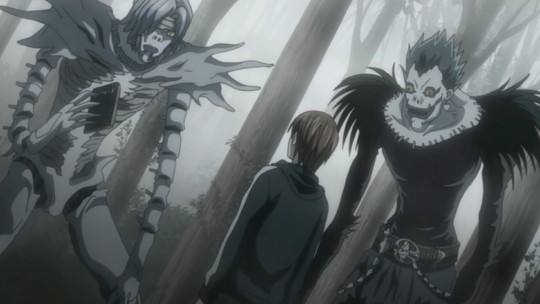
Tanaka not only never met another shinigami so he could understand how they would behave, but he also never met Near---I mean L. I gotta stop calling him Near.
He never got to meet L, he never got to meet the investigation team. All of Tanaka’s actions were met through the safety of his room. This was beneficial as he was able to cover his tracks, but it proved his downfall as he followed a plan from start to finish without thinking of the variables.
The moment Tanaka relinquished ownership, his fate was sealed. Tanaka wouldn’t have known about the rule change and it wouldn’t be up to Ryuk to remind him. Ryuk is many things, but Ryuk is a shinigami of his words.
It’s because of Ryuk being a shinigami of his word that proved to be fatal to Light as well. From the beginning of Light’s reign into Kira, Ryuk promised that if Light were to ever put himself in a situation where Light would die, Ryuk would write his name in the Death Note.
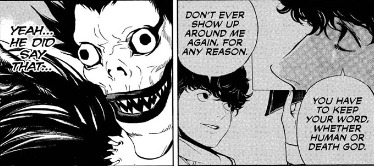
Ryuk never had the chance to warn Tanaka about the rule change as he was told never to show his face again. Thus, Tanaka died oblivious to anything that he had done, unlike Light who died knowing all of the things he’d done.
The final thing I want to reflect upon is the concept of legacy. Throughout the chapter we’re told about the lasting impression Kira had on not just Japan, but the entire world. It was this legacy that spurred the interest of ownership of the Death Note to begin with. Even if the Death Note was never used, the fact that it could be used to incite fear and dominance among one’s nation and the world is enough for anyone in a position of power.

The caveat of covering your path is that no one knows your name. This was the entire point of Tanaka’s ownership of the Death Note. He wanted to get rid of it while also making a profit off of it. If all of Japan would reap the benefits of the Death Note, then it was just a bonus.
His mother wouldn’t struggle, his family wouldn’t struggle, everyone would be set for life. This one child single-handedly caused an entire economic bubble and yet his legacy would be left behind with no one knowing who he was.
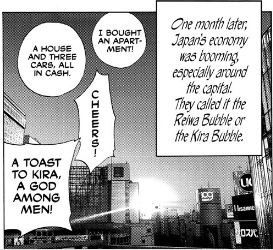
If you’re a fan of the series, I highly recommend giving this a read. In fact it makes me want to revisit the series one more time. It was nice seeing how my old favorites were doing ten years later, both literally and within universe. It was also a good read that, much like the original Death Note, left a lot to think about as far as current events.
The timing of the release of this chapter, the realistic physical details of the world leaders for USA and China, and the themes shared within the chapter are non-coincidental I believe. While a Death Note is obviously fantasy, it reads itself like a parody of modern-day politics. A caricature of the lengths those in power would go to obtain a destructive instrument used for intimidation purposes.
Unfortunately, even if you do everything in your power to just live a peaceful life, in the words of Ryuk…
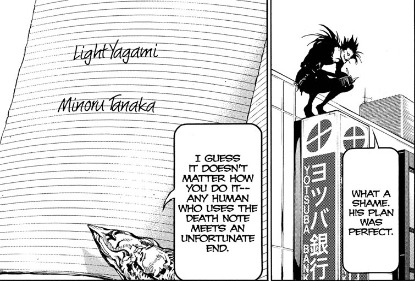
2 notes
·
View notes
Text
STRATA MUZAK Interview with PHARMACOSE Wes Jones (vocals, bass)
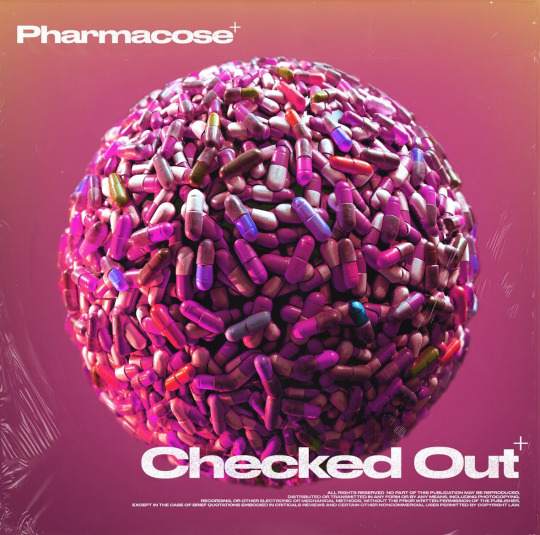
STRATA: What artists, in particular, you are drawn to (alive or deceased) that you listen to for particular moods? Such as happy/sad/contemplative/etc… Explain why you might listen to one artist for a particular mood.
It’s funny you should ask this question. Just the other day I was thinking about how I used to listen to Pink Floyd a lot when I was studying. I would put Animals, Meddle, Wish You Were Here, The Dark Side of the Moon, and The Wall, or some combination, and just study until I had listened to all the albums.
Eventually, that became The Mars Volta. I guess I like to listen to progressive rock while I study. My tastes used to become angrier when I would get depressed. I’d listen to Marilyn Manson or Nine Inch Nails or something of that sort. These days, since I don’t really have the mood swings I used to, I use music to hype myself up before training, like Chevelle or Queens of the Stone Age.
STRATA: Do you have a process you go through prior to writing, playing, and even performing?
I used to think I needed to wait for some kind of inspiration to write. But these days, since I still work as well, my time is more limited. So over the past few years, I would just sit down with my instrument and start writing. Lately, I have been staring at the computer, however. I find that if I just start tinkering, start doing, I can filter out some good thoughts and record them. So the key is just to start doing. I take the same approach to playing and performing. Just do it, and try not to think too hard.
STRATA: Your own current project, discuss the process your music went through as you built each layer. From beginning to the end of it.
Pharmacose has been around since late 2017, when I met Lu Rubino, our producer, and bassist.
We were introduced through a mutual friend. I had some songs I wanted to record, and my friend recommended Lu Rubino to me. We recorded those songs under the name Digital Array. We ended up pulling that record and changing our name to Pharmacose. We wanted a fresh start after we rounded out
our lineup. Lu had known Albert Cruz, our drummer, so we added him. I later met Kevin Horne, and he came aboard to play lead guitar. So we reworked some of those songs and wrote some new ones. We
have been grinding away in the studio for a while, so it’s nice to get to a point where we can release some
music.
As far as our current single, “Checked Out,” I didn’t really know we were going to write it when I went to Lu’s studio one day. We had finished the Digital Array album, but it didn’t really get any traction, so I was eager to start getting some new material together. We had been using material I had written over the years, but we had recorded everything from that stuff that I wanted to. Lu and I had talked about having a session to do a song that we would write together, so that was the plan. I had kicked around a few riffs beforehand, but that was it. So when we got started, I just played one of them for Lu. It ended
up being the bass line more or less. We started recording as we were writing. Lu had the idea for that washy lead you hear in the verse. He and I then came up with the chorus. We wrote the progression
together, but I thought it needed some more power so we added in the rhythm guitar that you hear. I remember thinking how cool it was that everything was coming together so well.
Once we had gotten all that tracked Lu started putting down some temporary drum tracks. He also started working on the bridge. That’s when I started writing lyrics. For me, this was several months, maybe a year after I had a bad manic episode, and I was still dealing with the impact it had. My doctor and I were still trying to get my medication regimen hammered out, so while I wasn’t feeling particularly bad, I wasn’t feeling great, either. I had pretty much isolated myself, not doing much besides working and playing video games. I just felt like I was existing more than living. I had gotten stuck writing the lyrics, so Lu and I took a break and were just talking. I was telling him all this, and somewhere along the way he used the phrase “checked out.” I immediately jumped on that and was able to finish the lyrics. After that, we recorded the vocals, and we were pretty much done, although we would have Albert come in and put down some actual drums during another session. We did it in about 5-6 hours. We did the video last November. Lu knew our director, Kurt St. Thomas, from just living in St.Augustine, so we all got together for dinner one night. I think we all just clicked. Kurt had a vision with what he wanted to do with regard to the tone. I remember he mentioned 12 Monkeys and The Cube. My contribution to things was wanting it to tie into being in a mental ward. So that’s how the storyboard got put together. Kurt has made a lot of great videos, so he just got the whole thing organized and we filmed it in about a day and a half. He put together a great crew, and that made things so easy. It’s funny because the padded room you see is actually just cloth over pizza boxes. I thought that was really clever, and it looked great! We’re really thrilled with how it came out. The twist is that one of our managers, Mark Fischer, pitched the idea of filming a second video for our song “The Clearing.” So we knew going into the weekend that we were doing two videos. It’s getting edited right now. Maybe we can chat about that soon as well!
STRATA: Can your music personally be an open to change in the world of artistic exploration? In Other Words… how comfortable are you as an artist exploring other types of music and creating projects that might be totally different than what you are creating now?
I think in the future, you will hear a variety of sounds. We have at least 12 songs over 2 EPs that we will be releasing this year, and those I feel have an alternative rock sound, more or less. But we are already writing new material for next year. Kevin and Albert already are contributing to the sound, so it might be a little more metal in some areas, and a little more progressive in some areas. I’ve been experimenting with synths a lot lately, so I anticipate that there will be some electronic elements at play as well. I’d also be open to other projects, but Pharmacose is my main focus at present.
STRATA: Are you open to change your style, genre even, and how you approach what you create every time you enter a studio? Or do you find once you have a formula in place do you find it best to stay with what you know? Many times artists will change how they approach their songwriting
and even their recording staff/producers.
I try to have something in mind when I go to the studio, but I also try to be flexible. With the earlier stuff, I had pretty much-written everything before going into the studio. But more recently, I have come with an idea, and then Lu and I have built on it like I described earlier for “Checked Out.” I don’t think jamming in the studio is always the most effective use of time, but sometimes it works. For “Victory at Wit’s End” we were actually recording another song, and during a break, Albert and I were jamming. That song was the result. What I find interesting is that after Lu added the lead guitar lines, it was a completely different song. So even when you do have something in mind, and an idea of what you want it to sound like in your head, the result can be much different, and oftentimes better. I think that’s why it pays to be flexible in the studio.
1 note
·
View note
Text
Pokémon the Movie: The Power of Us Review
Pokémon the Movie: The Power of Us
(Japanese Title: Everyone’s Story)

Review
There was an old statement from former Pokémon anime head writer, Takeshi Shudō, about Ash Ketchum (Satoshi). On his personal blog, he has claimed that Ash, as the main character aimed for children, could not be written as anything beyond the plain and simple stereotypical hero. And that to compensate for his vanilla personality, Ash needed to be surrounded by “fascinating villains and rivals” such as the Team Rocket trio. While I disagree with the notion that Ash Ketchum can’t be an interesting character by his own right, I find it to be the best method to tell further stories of Ash when nearly all of his character development has been done. The problem with Ash in recent Pokémon TV series and movies is that his early hotheaded and inexperienced personality, which made him a relatable character for many viewers, has all but phased out over time; in its place is the standard Shōnen stock hero. It makes sense for Ash to reach that stage in his character arc, but his personality is now more generic and thus less interesting to watch. So how would anyone tell an interesting story about Ash without regressing his character development he had earned over the past several years?
Enter the new director of this film, Tetsuo Yajima. Tetsuo Yajima had previously worked on the Pokémon anime as a Storyboard, Key Animation, and Episode Director since the Black and White series. But he didn’t rose to prominence until he was helmed as the Series Director of XY and XYZ. Under Yajima, the XY series did something unique with their approach of Ash Ketchum. Rather than just focusing from Ash’s perspective, the series explored on how Ash himself affects everyone around him; from his companions to his rivals to even the bystanders that otherwise have no impact on the main plot. As a result, we got an array of characters with their own quirks and storylines, and we could contrast all of them with Ash as the foil standard. This approach became the base foundation for the story of 21st movie and in my opinion, all the better for it. After all, it is everyone’s story, not just Ash’s.
The movie begins not with Ash and Pikachu, but with a new character Risa (Lisa). Unlike our main hero, Risa is not a Pokémon Trainer. She’s a former athlete runner who is tasked by her injured brother to go to Fula City’s Wind Festival celebration and catch a Pokémon for him. Shortly afterwards, we are introduced to a little girl named Margo (Largo) and her father Oliver, mayor of Fula City, leaving their mansion to prepare for the festival. And as we finally arrive to the city itself, it’s there we meet the rest of the ensembled cast. There is Callahan (Kagachi), a boastful braggart who lies about his achievements to his young niece Kelly; Toren (Torito), an insecure and timid scientist under pressure from his peers and scheduled presentation; And Harriet (Hisui), an old woman who hates Pokémon and wants to be left alone. And in the middle of this multi-introduction is Ash and Pikachu, who are closely followed by Team Rocket.
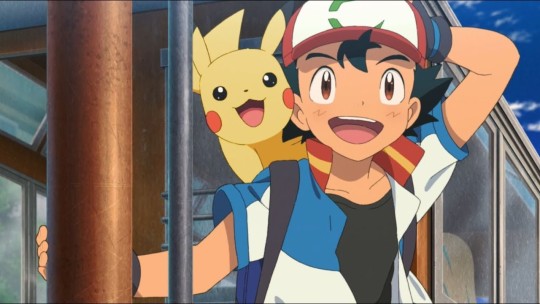
All of these characters have a distinct flaw that they must face and overcome as the movie progresses. The sole exception is Ash Ketchum. If you expect Ash to be some sort of immature idiot or a failure trainer, you are clearly not familiar with Yajima’s style. This Ash is an ideal trainer, an ace who easily gains the admiration of his peers and rivals for his skills, lessons and selfless heart. His character doesn’t change at all throughout the movie, but that is a good thing. It fixes a crucial problem that previous Pokémon movies have, where they would either focus too much on Ash at the expense of everyone else or simply shoehorn in stories where he is not needed. Having Ash be this supporting mentor figure allows the ensemble of new characters to take center and leave a lasting impression for the audience, while also making Ash integral to the overall story.

The characters themselves are all memorable despite being one-shot movie characters of the day. Risa’s clumsiness and naivety are funny to watch and a great contrast to Ash’s veteran persona, who has to teach her the ways of the Pokémon Trainer. Callahan wanting to impress his niece makes him a sympathetic character despite the fact the comeuppance for his dishonesty is well-deserved. Toren’s crippling shyness makes me wish he grew a spine already. Harriet trying to get away from a group of Pokémon that always follow her is absolutely hilarious, especially with that domineering voice. And Margo is like a younger version of Ash, such as protecting her befriended Pokémon in the same manner that Ash would do for any Pokémon. And although Margo has a lot in common with Callahan’s niece Kelly, there are distinguished traits to tell the two apart.
Though the characters’ arcs all start separately, they all intertwine with each other naturally and frequently; whether it be Risa getting wrong info from Callahan, Toren accidentally spilling a Pokémon attract chemical on Harriet or Ash protecting Margo from a bunch of kids selling lemons. Though there some stories that are more interesting to follow, like Callahan and his lying habits getting him into trouble, none of them overshadows the others. They all had their heroic moments in the spotlight, and I can easily recall each of the character’s story arc despite the film juggling all of them in the climax of the film. It does live up to title of the movie.

These intertwinements, along with a few Easter eggs and details in the background, help create a living, breathing environment that is Fula City. With such a down-to-earth premise compared to other Pokémon movies such as Pokémon 2000: The Power of One, world building is essential to the film’s strength to retain the audience’s interest in the movie. Take for instance the film’s handling of the featured Mythical Pokémon, Zeraora. Unlike most featured Pokémon in modern movies, Zeraora is kept hidden for the majority of the story until near the climax where it finally reveals itself. Its presence is only alluded to in historical events and urban legends told by various citizens ranging from small kids to government officials. Whereas most Pokémon movies would have an exposition book or expert to explain everything about their featured Pokémon to our heroes near the beginning, this movie holds off on the major exposition until near the end, after a gradual buildup of clues and hints given to the audience an idea of what the exposition is going to be. By that point, the audience is already immersed with the personal stories of the cast ensembled rather than the mandatory promotion of a Mythical Pokémon for kids to get. In fact, this is perhaps the first Pokémon movie where the marketing focus in on the human characters rather than the Mythical and Legendary Pokémon. It’s why I haven’t mentioned Lugia, the featured Legendary Pokémon of this film, at all up to this point despite being a central figure to the Wind Festival. Lugia is not essential to the plot.

Moving on to the action aspect, there’s not a lot of Pokémon battles in this movie as this is a character-driven story. But the battles that are shown are impressive. The audience that I was in awed and laughed during these sequences. The animation, camera perspective and sound effects are top-notch, especially when combined with a scenic background and realistic interaction with the environment. It’s like the battles featured in the XY series, only sharper and more fluid. Unlike the battles in the TV series and most movies, where Pokémon battles take place in a designated field area with the trainers in relative safe distance, Pokémon can hit their own trainers by sheer accident or cause destruction of property when on a rampage. It’s a sense of realism that hasn’t been seen since the opening of Pokémon 3: Spell of the Unown, and I hope it appears in future movies.
Voice acting-wise, the English dub is actually good at least by The Pokémon Company standards. This is perhaps Sarah Natochenny’s best work as Ash here, and the rest of the ensembled cast all sound natural and pleasant to here. The only characters that may sound off are Jessie, James and Meowth of the Team Rocket trio, but they are not in this movie that long and much of the problem I have is due to lingering nostalgia for Rachael Lillis, Eric Stuart, and Maddie Blaustein. Script-wise, some of the wordings are very cheesy, like Ash’s inspirational speech about “Pokémon Power” to a group of people far older than him during a crisis. But I can’t really fault the movie as this has been the standard message that told over and over again in nearly all of the Pokémon adaptations, including the Pokémon Origins mini-series from 2013. The only thing I wish is that they could find better words for Ash to say other than just “Pokémon Power.” For people who have grown fond for the Japanese dub, this competent dub production will help get you through the movie.
It’s also helped by the fact that the Japanese music score (which contains orchestrated music directly lifted from the games) is retained for this film after years of The Pokémon Company constantly replacing it with a US score for international releases since the start of the XY series. The Japanese score is pleasant to listen even for non-fans; and it has the added bonus for long-time Pokémon fans to identify music they had heard during their playthroughs of the Pokémon games.

All in all, Pokémon the Movie: The Power of Us is unlike any other Pokémon movie beforehand. It’s not an action blockbuster nor a blatant advertisement tie-in to GameFreak’s recently released game (though don’t get me wrong; Risa’s Eevee is a promotion for Pokémon: Let’s Go, Pikachu! and Let’s Go, Eevee!). It could have gone for nostalgia, action hype or even over-the-top comedy for the movie direction. They would still entertain the audience regardless of critical scores. Instead, the film goes for a humble premise and focuses on the characters, their stories, and the world they live in. And that is what makes this movie one of the best the Pokémon franchise has to offer.
#pokemon#Pokémon Anime#pokeani#anipoke#Pokémon movie#pokémon the movie#preview#M21#everyone's story#the power of us#fathom events#tetsuo yajima#director#Ash Ketchum#pikachu#risa#margo#callahan#toren#harriet#mayor oliver#lily#mia#rick#eevee#pokémon power#i haven't done this in a long time#fula city#let's go#zeraora
24 notes
·
View notes
Text
The Influence of 12 Angry Men on American TV Shows
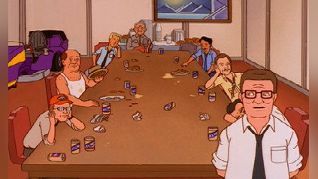
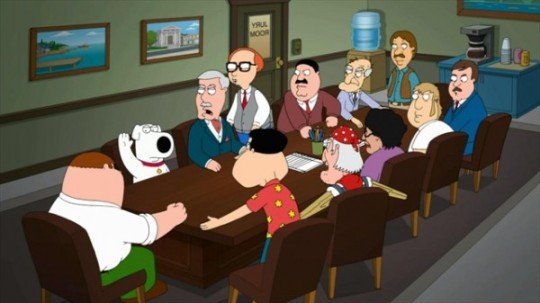
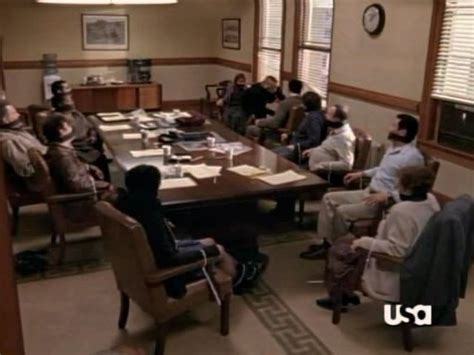

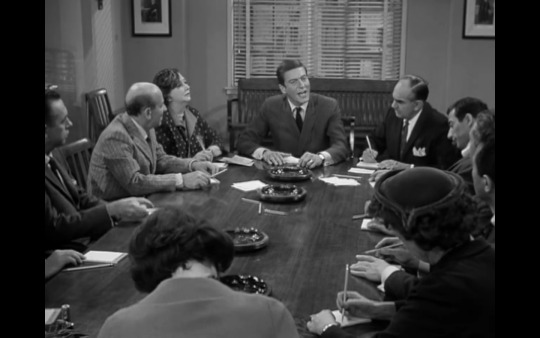
The movie 12 Angry Men (1957) is included on the AFI list of the 100 Greatest American Films and a couple of my housemates were asking me why. It is true that, although a good movie, it is not really ground breaking in any way. It was considered a box office failure at the time it was released and it didn’t win any Academy Awards. The story wasn’t really that original except to focus on the jury side of a story as opposed to the open courtroom. So what makes it stand out? Most of it falls on the writing and the acting being excellent, but part of it is that it is just so dang easy to copy. To remake this movie, one only needs 12 people, something to disagree upon, a room with a big table and...well...that’ s about it. It is so easy to recreate and has such a powerful story (one voice of reason standing up against the biased opinions of many in an attempt to ascertain the truth) the really speaks to the American people. To show you what I mean, here are five episodes from popular TV that straight up copied the storyline:
King of the Hill - Nine Pretty Darn Angry Men: A slight subversion from the original, this episode from the animated series sees Hank and some of the other main characters judging a new lawn mower that is an upgrade from the previous model. Instead of being in court, the 9 men are in a shopping mall focus group that have to praise or criticize the new product. Although it is not in the legal domain, it is a group of men separated in a room making a decision that sees one holdout versus the rest of the group. At first it seems like Hank is ragging on the new machine because he owns the old model, but he is able to win over the group by pointing out the fundamental flaws of the new model.
Family Guy - 12 and a Half Angry Men: A complete copy of the storyline, this is just the movie with the local mayor being the person convicted of a crime. In this version, it is the Griffin family dog, Peter, that is the only hold out on the jury. It seems that it would not be that much easier or cheaper to have all the characters in one room when dealing with animation, but a simpler background in a single setting does making for easier storyboarding and simpler animation.
Monk - Mr. Monk Gets Jury Duty: A strong subversion from the original, this version has a holdout but it is not the hero of the group. The one holdout is actually a villain in this episode because she is in league with the defendant and is trying to draw out the case to either hang the jury or give the criminal a chance to escape. Detective Monk is on the jury and figures out what she is doing so she holds the group ransom in an attempt to let the defendant go free.
The Andy Griffith Show - Aunt Bee, The Juror: Slightly different in that there is more contact with the world outside the room during the deliberation, the female character “Aunt Bee” is the holdout on the jury. This gives the main character, Sheriff Andy, the opportunity to go out and find the real culprit. This particular show had a lone woman standing up against 11 angry men and it was supposed to be empowering for women. It really didn’t turn out that way since the only reason she was able to hold out against the group was because she had the town sheriff working on her side.
The Dick Van Dyke Show - One Angry Man: This was a straight up copy of the film but with a lesser crime. The lead character, Rob, is a hold out on a jury that is trying a suspect of robbery. This is much more of a comedy and less a drama, but everything is pretty much the same.
12 Angry Men showed that great things can be done with a simple set and a small budget as long as the storyline is good the actors are passionate. All of the voices of the jurors are like all the little voices going off in your head when trying to make a difficult decision. The jury room is very simple and the deliberation can be made longer or shorter depending on the run time of the media. This makes for a perfect TV episode. In fact, 12 Angry Men was a made-for-TV special on CBS before it was ever a movie. I guess some stories lend themselves well to the small screen, and this is a prime example of one of the best.
#family guy#monk#the andy griffith show#dick van dyke#king of the hill#courtroom dramas#television#12 angry men#introvert#afi movies
16 notes
·
View notes
Text
RWBY - Volume 6, Chapter 5 Production Analysis

Vol 6, Ch 1 Production Analysis
Vol 6, Ch 2 Production Analysis
Vol 6, Ch 3 Production Analysis
Vol 6, Ch 4 Production Analysis
It can be a bit scary when I’m right on the money about something. The previous production analysis for volume 6 ended on a note pointing out how there were less names in the animation department section of of ending credits of chapter 4 compared to prior episodes. This led me to wonder if either the animators more heavily involved with RWBY would either be working on Gen:Lock at around this point in the volume 6′s production or their time and attention would be spent on a later episode. I am happy to find that it was the latter but also admittedly shocked to find that the “later episode” would be this one.
Before diving into the bit everyone has been losing their minds about, let’s briefly talk about the storyboards and camera layout in the opening scene. Despite having spent time extensively dissecting how Rachel Doda does storyboards and camera layouts in the scenes she’s assigned in the the production analysis for chapter 2, I try to be mindful not to let confirmation bias get the better of me as I’m trying to learn more about the other storyboard and camera layout artists within the show. That being said though, it wouldn’t hurt to least make a conscious presumption that the first sequence had her involvement given the cues and techniques mentioned before. A similarly-presented panning shot and blocking between characters to highlight the reveal of one of them, among other things are signs that Rachel Doda either did the boards or the camera layout for the setup of the scene and probably even the fight itself.
Okay, now to finally address the elephant in the room. Neo is back and in a redone character model no less! Of all the characters to have had a recurring appearance into the show, she has by far been given the most unconventional approach. Many fans by now are aware of the gist as to how she came to be, but for those not in the know, Neo was a character that was conceived a mere 10 days prior to the release of volume 2′s fourth episode. Her design was partially inspired by a genderbent cosplay from Sonja Carter, otherwise known as Soulfire Photography. Her semblance was the result of from is the result of Monty Oum needing an easier way to animate her and Torchwick making a quick escape according to the volume 2 blu-ray directors and animators commentary tracks respectively:
“I needed an uh, it's so backwards how like, I needed them to exit the scene like, Neo was like Torchwick's escape plan. And I was like, "oh yeah, they could get in the ship and then get away." I was like, "That's hard to animate.” Let's just have them shatter into glass, that's simple!"
“And then we have Neo come in and do... something weird. I guess, I tried to think of it as an illusionary technique. It’s like her version of ninja smoke bomb where it’s like she gets away because she causes some sort of distraction because the umbrella is relatively fast, the ship was probably waiting.”
Her entire character was born from the kind of creative process Monty had in general. It’s something he was a bit outspoken about where he compared his own process to that of most film or animation productions, referring to the latter’s structured, step-by-step process as “baking”, while he referred to his own personal, improvisational process as “stir-frying.” Both approaches have their merits and faults, but whether or not one is seen as more favorable over the other in animation production is not the point to get across. Rather, it’s to point out how a character like Neo can come to be in the first place:
“ When I’m working on my own, I tend to run editorial and animation concurrently. I’m averse to storyboards and over-planning. I like to talk about traditional 3D pipelines as being akin to baking: everything is very deliberate and methodical. My version of 3D animation is more like stir-frying. It’s very live and in the moment. If I need a model, I make a model. If a shot or sequence isn’t working, I’ll cut it, move it, or use it later - sometimes several years later.”
-Monty Oum, interview at Creativebloq (yes, they spelled “RWBY” wrong)
So with the story of how Neo came to be out of the way, let’s talk about her in action sequences since a lot has happened in RWBY’s production between last appearance and her grand return. Up until now, only 3 people have ever had a chance to animate Neo fighting. Monty Oum during chapters 4 & 7 of volume 2 and Joel Mann and Andrea Caprotti in chapter 11 of volume 3, the latter two also animated Cinder, Emerald, & Mercury vs Amber in chapter 7 of the same volume. Without going too much into detail, my stance on Monty and how he created fight scenes have always been more conflicted compared to the general consensus. A lot of that has to do with two of the several hats he wore up until his passing, his role as the show’s initial director and as lead animator. As the director, it always felt unclear as to how much thought was considered behind the character motivations within a fight or the consequences that would logically follow after one. Something just feels off in hindsight when say, a criminal wreaks havoc on a highway by knocking away multiple cars, using a mech that’s stolen, top-secret military property and we don’t ever get a scene showing the military general’s reaction to the incident, whether or not he ultimately does anything about it. As much as I appreciate good choreography and rhythm when I see it, having the story being weaved within and around a given fight in works of fiction is what can make them engaging in the first place.
That being said, Monty’s skills as an animator were definitely made clear in the fight scenes he assigned himself to within the show. Animation in general is not an easy medium to tackle, regardless of what kind of gestures or expressions one wants to sell and creating action sequences require both the 12 principles of animation and a few other guidelines in editing and cinematography to make them engaging. In the case of the character Neo, Monty made it very evident what kind of character he wanted to portray through her body language, facial expressions and poses. She fights in a classy way, but unlike Weiss Schnee who is shown as being more consciously routine and disciplined, Neo is comparatively more sassy and provoking. She likes to push her opponent’s buttons with the way she dodges, defends and attacks. Jumping into volume 3, Joel Mann and Andrea Caprotti picked up the pieces from where Monty left off up until his passing and captured much of the same personality to how she fights. Finally, three volumes later, we have her fight with Cinder in this chapter. Not only were just about all of the same traits with Neo’s character left intact, but the list of animators involved this time around were a pleasant surprise. Matt Drury, Megan Pellino, and Joe Vick were confirmed to have animated the fight with current assistant lead animator, Melanie Stern providing some assistance by animating a couple of shots herself. I’ve gone on record in previous posts on how between volume 5 having on of the biggest waves of new recruits, the overall restructuring of animation teams between RWBY’s sixth volume and Gen:Lock on the horizon, and the staff list on the Adam Character short, it’s now more important than ever to remain aware of who will be animating any fight scene or non-fight scene. “Keep moving forward” is a golden phrase within the fan base originally uttered by one of Monty’s tweets and this mantra can be applied to acknowledging new names involved in the production rather than staying stagnant. This episode is a good example of why that’s vital.

This fight sequence was not only an opportunity to show off the return of a fan-favorite character, but it also needed to formally establish the narrative reason as to why Neo is here now. Keyword being “formally”. Yes, fans have spent weeks speculating the possibility of her character through the opening theme and the second chapter. But that doesn’t change the fact that the CRWBY have been spent several months on the production of this part of the volume and still need to make it clear what this character’s motives are for appearing again after a few years without the scene coming off as pointless fanservice. That can be especially challenging for a mute character, but Melanie, Matt, Megan & Joe made that all clear through the choreography and more importantly, the emotional action and reaction. Despite the supposed intentions to why she’s combating against Cinder, Neo is all about taunting her opponent. So it’s only natural that she would ride the line between fighting aggressively and playfully, going as far as momentarily taking out her blade via a split-second smear, all while displaying an appropriate grin on her face. This constant assault in turn escalates the intensity from Cinder’s perspective by shifting her emotions from confusion to frustration. She drops being defensive and starts swinging fists and kicks so aggressively, that her actions come off a little animalistic and she eventually gets more acrobatic and starts breaking furniture.
Though none of Cinder’s actions and reactions are displayed senselessly, despite her facial expressions and vocal cries on Jessica Nigri’s part suggesting otherwise. In the fifth episode of season 2 of CRWBY: Behind the Episode. In it, Matt Drury. who seems to have animated the bit with Neo and Cinder going at it on the bar stand, talked about applying the notion of “see, think, do”, in which a character stays keen on his/her opponent’s movements based on what the latter is going to strike with and then responds accordingly. It’s essentially something learned in Martial arts in general, even competitive fighting games apply this concept. The same use of “see, think, do” can also be seen in Matt’s previous animated sequences in the Adam Character Short. Despite wearing a mask, there are various alternative ways he goes about handling each opponent such as the gunshots in the forest sequence and the framing of shots in the Schnee Dust Company facility to help see what Adam sees and thinks.
I could go on about how great the physical aspects of the fight turned out adding the great use of staging in certain shots and even the brief instance of Neo attacking with her hidden blade through the different colored smears and sound effects that would’ve been easy to miss otherwise. But there’s still a bit more to talk about Neo and Cinder’s conflict outside of the fighting animation. Being a mute character, facial expressions are important to get right in both fighting and dialogue scenes and when Neo’s worn-&-torn character model is shown, heartache, surprise, fear and reluctance are all emotions made very clear. Finally, there’s some 2-D visual effects, likely from Myke Chapman again, this time in the form of wind. I can only imagine the overall design of the wind column surrounding Cinder is fairly elaborate to animate, despite it being looped. But it’s pulled off really well. The wind seems to be divided in three layers: there’s the swirling wind in front of Cinder, the wind swirling behind her and the base on the bottom which seems to be animated on 2s while the former two are animated on 1s. There’s also the additional wind bursting out at the bottom when Cinder levitates up or back down to the ground. Even though I have praised the 2-D effects in chapter 3, a bit of concern was felt as to whether the timing would be played around enough by utilizing what is called “frame modulation”. To put simply, the phrase has to do with an animator fluctuating between animating a sequence on 1s, 2s and 3s, depending on what exactly is meant to be conveyed. This was what I was slightly worried about with the 2-D effects going forward, but thankfully, this one effect soundly put the concern itself to rest.
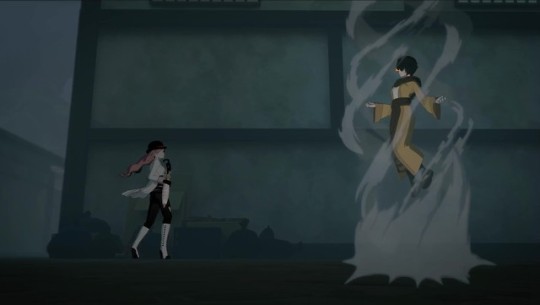
Despite the harsh criticisms being common knowledge at this point (some of which are certainly valid), I have contrarily been willing to defend the general presentation of fights in volumes 4 & 5 for at least tapping into the idea of more consciously displaying the motivation and consequences between characters engaged in conflict. That being said, both the emotional narrative and physical choreography can both coexist and this Neo vs Cinder conflict served as a great, concise example of just that. I would not necessarily call the scene a “return to form” like many fans have been quick to state. But that should not take away from the level of effort being paid off in the first half of this episode serves as a effective reminder of moving forward to acknowledge both new and recurring talent. With that said, the topic of Cinder vs Neo has been greatly exhausted so let’s move on to a different change of pace in the latter half of the episode. It’s almost night and day in terms of what to break down with the Brunswick Farms scenes. Though there is just as much to talk about, just for mostly different reasons. The latter half of the episode has more emphasis on character acting through a mixture between motion capture and hand-keyed animations, timing of staging of moments through camera layout and editing, 3-D effects for the snow, and even the sound effects taking the spotlight to capture the eerie feeling of the setting.
Speaking of sound effects, let’s talk about that. Despite, talking this series of posts being about breaking down and speculating the production of RWBY, I’ve admittedly been very negligent on the audio and mixing up until now. But the audio department’s effort definitely deserve their due this episode with Chris Kokkinos taking the helm as lead of said-department since volume... Immediately, the sounds of the winds picking up in the storm are the first things made clear to the viewer. Even though there are dissolve transitions to shots of just the snowy setting for a few seconds, with the visibility being deliberately kept at a minimum, one can’t help but be drawn to the audio of the harsh winds. Once they barge inside, the music actually drops entirely for a moment and the sounds within the household immediately come to play. The creaking and footsteps of the wooden floors increase the tense feeling that something is amiss and though the music starts again once Ruby spots the family portraits, it doesn’t fight against the sound effects for attention. Next is Kara Eberle’s well-done screaming and panicky breathing as Weiss which is probably the only moment where the vocal delivery plays a punchy part of the uncomfortable setting. That, combined with the zoom-out from Ruby and Blake entering the room to seeing the rotted, sleeping corpses serves a great reminder of why I don’t care for horror movies in general, regardless of how laughably bad they can be. Congratulations CRWBY.
Next is the scene with the gang at the living room, starting with a shot of the fireplace. It’s more 2-D effects work on the fire which is simple and serviceable, though I’m not the most fond of the... “rendering” of the soot, for lack of a better way to explain it? It’s slightly jarring to look at in that it’s made too obvious that the elements of 2-D and 3-D don’t mesh as well as they could. But it’s really just a nitpick when all is said and done. The fluctuating shadow or lack thereof is interesting however since this extends to the characters. As much as the Pencil plug-in in 3DS Max has served as beneficial to the overall shading effect in RWBY’s character models for the past few volumes, making shadow flicker in front of a stable fire does not seem to be that doable. Whether this is due to lack of a simulation feature or it being possible to do manually but too time consuming, what very likely the lighting or compositing department have done before and did again in this chapter is use a subtle flickering effect that doesn’t change the shading on the characters so much as it slightly dims the light source, being the fireplace. It’s an interesting trick and it works fine, though I’m curious whether there is at all a way to manipulate the shading itself or rim lighting if added via the Pencil plug-in. Though the rim lighting is definitely seen a bit later in a couple of shots with Weiss.

Moving on, the living room scene itself seems to have been at least partially animated by Asha Bishi since much of her tells in character acting are there. Very expressive gestures and a combination of Blake’s cat ear shifts and eyes widening with the pupils being a tad more dilated, the last of which is something that been made more obvious after the last CRWBY episode. With that said, it’s a little hard to pin down when her sequence of cuts end. Next is the cut with Blake and Yang traversing in the snow which is actually the first shot and only shot newcomer, Nyle Pierson has animated in the show as of this episode. It’s a small bit but it totally nails how Blake and Yang would go about dealing with harsh snowy winds differently with one covering herself while the other tries to tough it out. Plus the follow-through on their clothing and hair are very well handled by avoiding feeling too similar, almost distinguishing which character’s clothes are sturdier. Now would also be a good time to briefly talk about the snow effects in this chapter and in this volume in general thus far. It’s all possibly a simulation done via Adobe After Effects from the compositing team since it doesn’t really interact with the main cast themselves. One exception though may be the moment Qrow stepped inside to dry off, though it’s honestly hard to say. The snow being brushed off seem to be done by the visual effects artists, but the wet spots formed on the floor may have been composited since they fade into the ground.
Moving into the shed scene, the quiet atmosphere is consistently well-set where only the sound effects and voice acting are heard. The choice of boards and camera layout also help ease into the sense of intimacy being brought between Blake and Yang’s conversation, going from wider and more distant shots that show the entire interior to having more medium and close-up shots and then back to a wider shot to take things back to square one. The last shot of this scene especially couldn’t be any more obvious as the visual equivalent of being given the cold shoulder. The animations through the facial expressions and gestures also serve to compliment the intention of the scene. I want to say Hannah Novotny animated this, but It’s still a little tricky to say for certain since she and Asha have similar approaches to animating the same characters. Jumping into the last scene of the episode and we get a couple of neat lighting choices, particularly with the small flames from Weiss and the flashlight on Ruby’s scroll. The show is no stranger to artificial lighting via vehicles and objects, but there hasn’t exactly been a light source done as small and bright before. There’s also an interesting detail by having the shape of the light be a couple of rings. Aside from that, nothing else to add beyond the cute, comedic character acting between Ruby and Weiss at the end of the episode. Not sure who the animator was that worked on it, but it served as an appropriately small, light-heard break in an otherwise very atmospheric set of scenes.
With that, this marks the end of another production analysis for volume 6 thus far. Despite the length being only slightly longer than the previous episode, chapter 5 had more going on overall with a more varied change of pace between the two-halves of the episode. With the return of a character who has been overdue for another appearance and a setting that invites visual and audio techniques from the horror film genre, it’s a bit hard to imagine how much more absurd things will go. But based on tweets Miles Luna and Melanie Stern have been teasing, things are expected to get even more nuts. This has made me especially curious as to what the next chapter or so is going to offer. One more thing to add: I want to give a special thanks and shout-out to Changyuraptor from the RWBY sub-reddit and his Source McGourse document on practically every confirmed scene each animator has done over the course of RWBY’s production. As much as I do my best to keep track of who has done what, Changyuraptor is arguably more on top of things than I am when it comes to searching high and low for any up-to-date information of confirmed sequences in volume 6 and a couple of the animators I found out from him.
#rwby#rwby6#rwby spoilers#rwby analysis#crwby#production analysis#production#analysis#matt drury#matt#drury#megan pellino#megan#pellino#joe vick#joe#vick
6 notes
·
View notes
Text
ARTISTIC THEMES
Personal Themes: I feel like most of my artwork has some kind of personal theme or story embedded into it. Most of the time it isn’t planned and it just happens as the artwork develops. Looking back on my artwork, especially during elementary school, every piece was just a reflection of the world around me. As I grew older I shifted away from having my personal life the main themes in my art. I didn’t want to feel too attached to it. Still, I always found it interesting when an artwork has some kind of personal meaning behind it that no one but a select few truly knows. Hence, little details of my life can be seen. As I further develop my artwork in my career I hope to leave little clues about myself in my art. Little stories about my life so that my audience can see me alongside my work. Depending on what I do with my work I would like to try to just get people to see the world from my point of view. I feel like everyone has a story to tell and I think that the best way to share mine is through my artwork.
Narrative: If there is one thing I love in this world, it is a good story. From films to literature I just love hearing about fantastic people and their adventures. Growing up, I was particularly fond of animation and comic books. Images that didn’t necessarily need dialogue, because the art told the story just fine on its own. It fascinated me that there was a way to tell a story without words. Specifically, Disney’s Fantasia was mindblowing as a kid, and even as an adult. Being able to mix music and visual art in a way to tell a beautiful story is awe-inspiring. As I develop my own work I would like to learn more about narrative artwork. While I am a firm believer that art doesn’t need to have meaning to exist, I would like to hone my storytelling skills. I think that taking classes that relate to narrative art and doing more extensive research on things like illustrators and storyboarders will help me towards my goal. I especially want to look after female narrative artists like Domee Shi and Sally Cruikshank. With companies like Disney and Pixar being more open with how their animation studios work it opens the door for more research.
Fantasy: As mentioned before, I love a good story. Especially those that take you to another world. Growing up, I was emersed in the world of Disney, Star Wars, Marvel, and just about any book I could get my hands on. I feel like the best kind of media is the kind that transports you and that’s what I want my artwork to evoke. I think that sometimes that we, adults, get so caught up in our everyday lives that we forget to use our imagination and explore and release our playful side. I believe that visual art is an amazing way to do that. In my artwork, I often try to evoke a childlike whimsy in everything that I do. I would like to expand on this as I develop what my art becomes and what I decide to do with it. It is so important for us to give our brains a bit of a rest and let them be free from the shackles of logic and I feel that art is an amazing way for a person to experience that.
Social Commentary: It is imperative that we know what is going on in the world. I think one of the biggest issues in our society right now is that people either don’t understand what is going on in today’s social climate or they simply don’t care. I believe that art is one of the best ways to be a social commentator. Social commentary art can tell your side of the story or express your opinion in a way that speaks volumes. While social commentary art has been around seemingly forever, with the rise of social media and graffiti artists like Banksy, social commentary art is becoming more popular. I feel like there should definitely be more taught on this subject, especially with today’s social and political climate. I am still learning how to do proper research on social issues and often lack the confidence to put social commentary in my artwork. I have some personal things to get over before I even think of putting social commentary in my art, but I definitely think it would help my grow as an artist.
0 notes
Text
ANN Interview: Made in Abyss Composer Kevin Penkin
This is all originally from an Anime News Network interview.
Interview: Made in Abyss Composer Kevin Penkin
Interview Info:
October 7th, 2014
By Callum May for Anime News Network
As a person who is aspiring to become a score composer (kind of an unrealistic dream that I can’t seem to let go), I found this really, really interesting. I left a lot of stuff in because I feel like there’s so much to unpack, and most of the information is interesting to me.
I did edit a few things out (mostly not music related), and I put in some square brackets for the sake of explanation and context.

It appears that all of your anime soundtrack work has been with Kinema Citrus. How did you come to work with them?
I met Kinema Citrus when we were attached to the same project called "Under the Dog"[...] Since then, we've enjoyed a wonderful relationship on other projects such as Norn9 and most recently, Made in Abyss.
Do you expect to be working on anime outside of Kinema Citrus in the future?
That would be lovely. It's not entirely up to me, but that would be lovely. I'm very grateful to get any work in anime, as I'm very, very passionate about this industry. If I do get the opportunity to work on another project from any company, I would consider it to be a great privilege.
What was your first reaction to Made in Abyss when you were approached with the project? How much of it did you get to read?
I was given the first 4 books as source material to read and was immediately taken by the world that Tsukushi Akihito had created. The early stages of production were just me going through the books and finding interesting scenes or artwork to write music to.
Who did you have the most contact with on the Made in Abyss staff? What sort of questions did you ask?
I have a music director named Hiromitsu Iijima, who I would talk to on a daily basis. Every couple of weeks after a large chunk of the soundtrack had been written, we'd set up a meeting with Kojima-san [Director, Storyboard, and Episode Director] and Ogasawara-san [Animation Producer who works with Kinema Citrus] to discuss the current state of the soundtrack. We'd discuss if there were any points of concern or if anything needed to be changed. We essentially repeated that process until we were ready to record, mix, and finalize the music.
What sort of instructions and materials were you given in regards to making tracks for Made in Abyss?
In addition to all the manga books, I got a lot of background and concept art that I could reference. Trying to match the visual colour palette and the musical "colour" palette was really important to me. For example, looking at how the foregrounds and backgrounds were so juxtaposed gave me ideas such as writing for a small ensemble of instruments, but recorded in a large space. This was meant to act as a metaphor for Riko and Reg exploring in this humongous, expansive cave system.
Could you elaborate on the idea of developing a musical "colour" palette? How do colours and music correlate?
It might be best for me to give some examples. Starting more broadly with Reg, he's a character made up of both organic and mechanical body parts. So combining organic and mechanical sound sources when writing for Reg felt perfectly natural.
Talking more specifically about colour correlation, there is a lot of information in colour that allows us to perceive essential things such as relationships and distances between objects. The sound has this as well. Depending on how you combine the essential components of sound (pitch, timbre, harmony, loudness, etc.) and controlling how they either complement or clash against each other is going to result in a specific listening experience.
“Depths of the Abyss” is another example of the musical key slowly “ascending” over time to act as a sonic metaphor for the Abyss rising up to surround and engulf our main characters. There's the flip side to this as well. The title track “Made in Abyss” features descending string passages to represent Riko and Reg's descent into the world of the Abyss. I've personally found that thinking about these sorts of concepts can be very helpful when trying to establish the palette of sounds (colours) that you think will complement and/or enhance what's being displayed on-screen.
How much did you know about how your music would be used? Did you know that Underground River would be used to introduce the world in a montage just six minutes into the first episode?
Syncing music to anime is a slightly different process than what I've experienced [...] In the limited amount of anime that I've done, I've typically been instructed to create music away from the picture, which is then matched to the desired scene(s) at a later stage of production. This might contribute to why a lot of anime music can feel like a music video at times. From what I've experienced and from what I can research, I've seen directors take large chunks of time out of an episode to let the music take over so that the audience can “breathe". Underground River is a good example of this. [In episode one] you're introduced to characters, their motivations, world building, monsters and action all in a very short amount of time. Taking a minute or two to let the viewer digest all this can be very effective, and music can help with that.
You're also known for your work on Necrobarista and Kieru, two Australian indie games. What draws you to working on Aussie games, even after making your debut internationally?
[Being an Aussie], there's a lot of pride in how interesting and unique Australian indie games are. I've always had a connection to games and Australia. So even though I'm currently living in the UK, the fact that I'm still able to work on games with friends who are living back home is something really special.
It's not common to see an Australian in the credits for anime. Do you think musicians from outside of Japan are becoming more common?
I [...] grew up watching Dragon Ball Z on TV. There are actually two scores composed for that series depending on [whether you are watching dub or sub]. So I actually grew up listening to Bruce Faulconer's music for DBZ, not Shunsuke Kikuchi's original score.
[In regards to other foreign anime score composers] There are also other examples such as Blood+ with Marc Mancina, Gabriele Roberto with Zetman in 2012, and Evan Call has done quite a few things as well [like Violet Evergarden]. So I think while it may be becoming more frequent to see musicians from outside of Japan being attached to anime projects.
How would you say composing for games differs to composing for an anime series like Made in Abyss?
Speaking for myself, composing for games, anime, or whatever typically starts the same. I feel that if you're able to nail the concept and/or tone of the project, that's a big part of the process already completed. Then it's just up to the individual needs of the project. Games are typically approached from an interactive point of view. If it's film or TV, you need to know if you're writing to picture or if you can write with no time contractions like I described before. You sort of go from there really.
How would you describe that concept/tone of Made in Abyss?
Made in Abyss offered the perfect opportunity to get really specific with instrumentation. We had analog synthesizers, field recordings, vocal samples, and much more that were heavily manipulated to create distinct electro-acoustic textures. Deciding where to record was also a really important discussion, and we ended up recording at a studio in Vienna.
[It was] a huge, state of the art recording facility just outside central Vienna. I asked for a custom chamber orchestra comprised of three violins, three violas, two celli, one double bass, two flutes, two clarinets, one bassoon, two french horns, one trumpet, one trombone, and one tuba. Totaling 19 musicians. Each musician had their own “solo" part, meaning that there was up to 19 different “lines” being played at the same time during a piece of music.
The concept behind such a setup was to represent the small company of characters exploring the Abyss. Everyone's in this massive underground cave system, so I felt having a small group of soloists in a space designed to fit over 130 musicians was the perfect sonic metaphor for this. It just so happened that we were also working with some insanely good musicians and an unbelievable technical team as well.
If you were given the chance to collaborate on a soundtrack with one composer working in anime today, who would it be?
That's an interesting question. To be honest, I think I'd rather be an understudy of someone really experienced, rather than write side by side with them. If I could be a fly on the wall while Cornelius was writing Ghost in the Shell Arise, or Yoko Kanno while she was writing Terror in Resonance, that would be so, so informative. That said, Flying Lotus just got announced as the Blade Runner 2022 composer so I'd do anything to get in on that, even though it comes out in a few days (laughs).
Made in Abyss is one of the most highly regarded anime of the year. What do you think about the reaction to it?
I can't tell you how happy I am about the reaction to Made in Abyss. Writing the soundtrack was tough. The music is experimental in nature, and it required a lot of time and effort from many, many people. Everyone came together to make this work, and I'm over the moon with how it turned out.
#made in abyss#anime composer#anime news network#anime interview#score composer#score composer interview#ann interview
1 note
·
View note
Text
Anime News Network - Inside The Manga Industry with Felipe Smith, American Mangaka (Part II)
In the second part of our interview (find part one here), Smith explains how manga distorted his expectations of life in Tokyo a bit, how working with Kodansha got him to look harder at genres and audiences, and what four crucial tips must be followed by any American otaku hoping to work in Japan, too.

Did working through Kodansha's demands for PEEPO CHOO develop any skills you've found useful on subsequent projects?
The quick and simple answer is a huge, resounding... yes! The rigorous schedule and incessant deadlines I kept while creating manga in the Japanese market actually prepared me to work full-time simultaneously in two industries back in the US! Upon my return in 2012, I was hired by Nickelodeon as a storyboard artist – and later character designer – for the Ninja Turtles animated TV show.
During that time, I was approached by Marvel to revamp the Ghost Rider franchise. I created Robbie Reyes, wrote 21 issues of his monthly comic, drew two of them and illustrated covers for ten of them.
So, from 2013 to 2017, I worked in both animation and comics full-time, at the same time. It was a bit nightmarish, but definitely worth the effort. And it was a possibility, in part, thanks to my Japanese publishing boot camp experience.
With that “double-duty” wrapped this year, you've turned to a new project Death Metal Zombie Cop, which was funded through Kickstarter. How does it differ from your recent output?
[It's] my return to creator-owned comics and I'm very excited about it. I've been developing it since the end of PEEPO CHOO back in 2011. In creating it, I'm applying everything I've learned from the Japanese and American comic markets and I can't wait to release it!
You've said you got the idea while wrapping up PEEPO CHOO. What was the inspiration?
...A combination of factors. The most important of which is the need to tap into an identifiable genre with an established audience. Neither of my previous graphic novel series, MBQ or PEEPO CHOO, fit neatly into any genre. I could say, with no real risk of sounding bumptious, that both titles are pretty singular in their approach and subject matter – something I've always strived for. But, by the same token, though well-received, they did not reach a tremendously expansive audience, either.

Did your run on Ghost Rider shape the idea, too?
In contrast, [it's] probably my most-read comic book series to date. It's very true that because it is a Marvel book – and an expansion on a well-known franchise – it already had significant interest and an expectant fan base before its release. But I believe that genre specificity had a great deal to do with its greater success, as well. All-New Ghost Rider is an anti-hero “action” comic with elements of horror. Those are two tried-and-true genres with an important audience, and well-established tropes upon which to expand.
Sounds like these projects got you to consider potential audiences in different ways?
A fanbase is the life of a creator, and is essential to his or her existence and prosperity. A good creator will foster and grow a fanbase independently. But fitting neatly into genres – as was [explained to me] in Japan – can help a creator unite his fanbase with greater speed and efficacy. Thus, upon finishing PEEPO CHOO – and after four original series pitch rejections – I decided to try my best to find a story I could be invested in and tell effectively that would also fit in a designated, easy-to-identify genre… for once! [Laughs]
So, I picked horror and action – genres I've always liked – and then added “cops and crooks,” which is also a personal favorite of mine. What's funny is that the “zombie” genre element didn't really come into play until later in the development of the pitch, but once I found that piece of the puzzle, my mind was blown. I had never created a story with any supernatural elements, because I'd always strayed away from superheroes. But now, I found myself with a whole new set of storytelling possibilities and I got really excited.
So, your horizons were expanded, both literally and figuratively, after having to see the notion of genre from a different angle over in Japan?
As I mentioned earlier, the one series that caught the interest of my Japanese editor was also the one I eventually decided would most likely find a better place with a Western audience, and it was Death Metal Zombie Cop. As I also mentioned, upon my return to the US, Nickelodeon hired me on TMNT, and then I got a call from Marvel. And when the editor mentioned that he'd like me to pitch him an idea for a Ghost Rider in a car [as opposed to on his traditional motorcycle], and that I was pretty much free to create everything from the ground up… I had a few things I was dying to test out on the American direct market audience.
Now that I'm finally putting together Death Metal Zombie Cop, I can't say I'm really approaching it very differently than my previous creator-owned work. The major difference is that this series will be in full-color and I plan to release 24-page monthly issues, like an American comic series.

PEEPO CHOO explored the misconceptions American otaku have about Japan. How might manga give US readers – and aspiring creators – a skewed view of life across the Pacific?
That's a good question. Although I've found that the largest portion of Japanese manga stories take place somewhere in real-life Japan, near real-life Japanese landmarks and during some time in real Japanese history – whether it be past or present – in my experience, a great number of the “Japanese” characters portrayed in these manga do not truly reflect the character and behavior I've observed in the Japanese people.
What shaped your expectations before moving there, then?
...My only real perspective on Japanese culture, like that of many Westerners, was derived from what I saw on their TV shows, live-action or animated, read in manga or magazines, or from any Japanese person I happened to meet. Obviously, first-hand conversation and discussion with people is your best bet, when it comes to trying to understand or familiarize yourself with their culture.
Having lived and worked with Japanese people in LA, I was lucky to learn their culture in action, first-hand. The more I learned, the more I realized that the fictional manga characters I presumed to be realistic because of their true-to-life surrounding locations and attire were anything but.
What specific details might ring more realistic?
[If you are] the least bit observant, you'll see that people do not hug very often, nor high-five each other. “High-touch” is how it's referred to in Japan. And, in my experience, unless there's celebration or alcohol involved, they're rarely prone to any kind of loud outbursts of emotion, wild arm or body gesticulation, or very expressive facial communication. It only takes watching a bit of Japanese TV carefully to discern who is being a TV character and who is just a person [that] happened to be filmed by the camera.
In contrast, a huge number of characters in all media [all over the world] behave astoundingly differently from the norm. Imagine if every person you saw on TV behaved and talked like Ace Ventura, Pet Detective. You'd find that pretty strange. This is a topic I brought up to my editors on more than one occasion...
Were you trying to strike the right balance of realism and surrealism?
The concept of “reality” is something that I believed was essential to establishing a believable story scenario. The way characters behave and react to situations is a reflection of that reality. So, if I ever wrote a scene about a person riding a public bus, I would want all the details to be right and make sense…
“Does this person pay with coins or with a card?”
“If they're approached by an inebriated or deranged homeless person, what would they most likely say?”
“If they witnessed someone stealing from or hurting another, what would they do?”
If the character reacts to any of these situations in a plausible manner, then it's realistic, and therefore based on reality. Unless it's a comedy. In [that] case, we are now playing with the conventions of what would normally occur and turning them on their side.
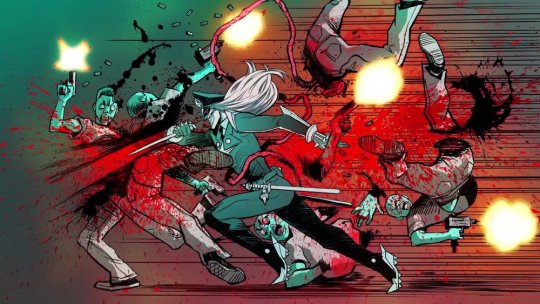
Did this anthropology study reveal even more about the manga business, in turn?
...Partly because I'm a foreigner, I found myself noticing more and more that these characters on TV, in movies and in manga… in many cases [they] displayed very uncharacteristic behaviors that did not match what I saw on the streets in real life. This truly confounded me, because I realized that my telling of reality in a story seemed to actually be of little importance in the overall scheme of manga storytelling! [Laughs]
I remember telling my editor, “Where's the reality in these stories? People don't own guns in Tokyo. People aren't this outspoken. People don't behave like this here. This isn't real. What's this based on? It's not reality!”
My editor simply answered, “Who cares about reality? As long as it's interesting [and entertaining], it's good.”
Sounds like you went through a process of enlightenment, much like the characters in PEEPO CHOO?
Unlike Milton [the manga's otaku protagonist from Southside Chicago], it was obvious to me that one cannot equate a country's cultural reality to its popular entertainment. [Still], I had no idea how oddly removed from reality I'd find certain aspects of everyday Japanese storytelling – be it in manga or just regular TV. I guess I learned that when it comes to Japanese entertainment, we should seek [it expressly as entertainment], rather than [as] “reality” or “truth”. [Laughs].
How was the series received by Japanese readers? Any surprises?
PEEPO CHOO was positively received by reviewers as a series worthy of merit for being the first of its kind. It also confused some readers, who took to the 2chan internet forums to discuss it and me as a creator. Some speculated that I was just a Japanese mangaka who wrote under a gaijin-poi “foreigner-like” pen-name to try to get attention. Others did a little internet research, found my earlier work – photos of me – and commented on how “he looks more like a soccer player than a mangaka!” [Laughs]
I remember my editor mentioning that some readers wrote in to the magazine commenting on my art – which they liked – and on how they had a hard time understanding the motivations of some of my American characters.

Speaking its reception, if anybody types “Felipe Smith Japan” into YouTube's searchbar, they'll find some interesting videos, won't they?
PEEPO CHOO also received some TV coverage on a few shows, including NHK's documentary show Manga No Genba – “The Place of Comic Creation” – which filmed me working in my apartment and walking around Tokyo running daily errands. [I was also on the] comedic duo Oriraji's show Manga No Hi – “Comics Day” – in which I had five minutes to pitch my series' premise to a panel of judges live, in Japanese.
Did you encounter any misconceptions about America throughout this?
...Upon meeting me for the first time, my editor assumed I owned firearms in the US – which I don't – and a few more silly things that escape me at the moment. [Laughs] But, encountering strange misconceptions and being asked outlandish questions by locals is pretty common when you're a Westerner living in Japan. It's something you just kinda grow used to.
What advice do you have for any American cartoonists who'd like to follow in your footsteps?
“Eat your veggies, get your sleep, learn Japanese and get to work!”
Creating manga professionally for a major publisher has a quantifiable effect on you mentally and physically due to its rigorous schedule, so it's important for you to eat healthy and get proper rest as much as possible. Sitting in a seat for 12 to 18 hours a day can have a lasting negative effect on you if you let it, so stay active and pay attention to your health.
Do they need to go to the lengths you went to, though – flying over and taking residency in Tokyo?
I've said it before, and I'll say it again… you don't need to be in Japan to create manga. But, if for some reason you want to do it in Japan, you need to speak the language in order to articulate your ideas to an editor. If that's taken care of, and your series concept is accepted, get ready to write and draw non-stop for very long periods of time – rain or shine, for as long as your series goes, regardless of whether you feel like it or not.
With no exaggeration or intent to dissuade, I can tell you from my own personal experience that a professional mangaka has little time for anything other than making manga. I can say, with honesty, that within the arts, it's a profession best suited for a very particular kind of artistic maniac.
#Felipe Smith#Peepo Choo#Japan#Manga#Kodansha#Felipe Smith Comics#Felipe Smith Art#フェリーペスミス#ピポチュー#漫画
134 notes
·
View notes
Text
Mortifying Tales of Post-Screening Q&As Emerge Online
https://ift.tt/eA8V8J
The post-screening Q&A is a lovely tradition that often retrospectively seems like it was better in theory than in practice. If you’ve been to a handful of them, you may be aware that the Venn diagram of people more inclined to get up and actually ask a question about the film they’ve just watched, and people who love to hear themselves talk regardless of the relevance of the subject matter, regularly appears to be pretty close to a circle.
One moment that audience members tend to dread when they pop along to a movie screening attended by a cast and crew brave and willing enough to field questions from an audience occurs when the mic is finally passed to an eager beaver and “hi, yeah, this is more of a comment than a question…” is the first thing that spills from their mouth.
Feeling trapped in your seat, you know damn well you’re about to hear either the worst opinion of all time or, if you’re incredibly lucky, a lengthy story only vaguely related to the movie in question. The brain recoils and straps in for the inevitable: as a collective, you’re about to experience paint drying in real time – you can only hope that any of you were smart enough to bring snacks.
But it could be worse, as Twitter has proven fairly well this week. Movie fans and industry professionals have been sharing their tales of post-screening Q&A woe online for all to read, and some of it makes for truly cringeworthy reading at that.
From the woman who asked Benedict Cumberbatch if she could taste his “deliciousness” before being escorted off the premises, to a hungover Mickey Rourke just hanging in there for dear life during his efforts not to vomit, this is just a sample of some of the worst post-screening Q&A stories shared on Twitter so far…
TIFF for Imitation Game, woman gets to mic and starts sexually harassing Benedict Cumberbatch, asks “can I taste your deliciousness,” entire audience erupts in mortified groans, Keira Knightley open-mouth shock, Cumberbatch barely fazed tries to laugh it off. Woman escorted out. https://t.co/AH6S6yQH67
— Brian FH Clement (@brianfhclement) August 12, 2021
Well this is just rude…
Got free tickets to a screening of Ex Machina at a small theater in NYC. My wife and I were snorting and making sarcastic jokes after like 20 minutes. Guy behind us shushed us and I gave him the finger and kept talking. When the film ended he got up to talk. Sorry Alex Garland
— Danny Brody (@DannyBrodyBX) August 12, 2021
Really putting the Q in Q&A…
This was a Comic Con and not post screening but someone asked John de Lancie, serious actor who happens to voice a My Little Pony character, what he thought about all the erotic pics and fanfic on Tumblr. The cringe took years off my life. https://t.co/oa1btKPkrO
— Laura (@laurahotch) August 12, 2021
How dare…
1st screening of ROGER RABBIT. When the lights came up, there weren't enough people left in the theater to have a Q&A.
— Frank Marshall (@LeDoctor) August 11, 2021
This is disgusting. Who wears sunglasses indoors…?
Happy memories of the THE WRESTLER q&a with Aronofsky & Rourke, in which Mickey Rourke, drenched in sweat and wearing sunglasses, crouched down on the stage to steady himself due to his colossal hangover. He gestured to Aronofsky to keep talking while he focused on not vomiting. https://t.co/s5CDPm46n7
— Whitlock And Pope (@WhitlockAndPope) August 12, 2021
After a screening of the Suspiria remake the host, ex-MTV Steve Blame, asked Luca G. to tell each other something they haven‘t told to anyone else. G. politely declined but Blame told a deeply private 10 minute long story about the things his mother told him on her death bed
— DerSoze (@kaisasoze) August 12, 2021
Oofgood…
I was at a 70mm screening of Willow w/ Ron Howard where a guy got up, complimented the film, asked if there were plans for a sequel. Then pulled a script out of his pocket for “Willow 2” that he had written. When the groans of 2nd hand embarrassment started, he was MYSTIFIED. https://t.co/qtJuhX0CXT
— Tanner Johnson (@TannerTrue) August 12, 2021
Will The Last Jedi discourse ever end…
Knives Out screening at Arclight where half the audience questions were about why Rian Johnson ruined Star Wars.
— Sean Mercado (@SceneMersaydo) August 12, 2021
Super Monkeyball…
I went to a screening of Jeff Who Lives at Home with q&a featuring Jason Segel and Ed Helms and someone mentioned Jonah Hills performance in Moneyball which led to an audience member repeatedly screaming “MONKEYBALL!!” Over and over again. https://t.co/LCCF9weT1d
— Good Ol’ Mike P (Available for storyboard work!) (@PattenPending) August 12, 2021
Doing his evil bidding…
THE NEON DEMON. Refn up on stage held up the Q&A and told us all to wait because he was bidding on some movie memorabilia on eBay. Just ignored everyone and looked at his phone. The audience had paid extra for the special screening. It was awkward as hell.
— William D'Annucci (@CountBillStein) August 12, 2021
Man Who Fell To Woof. I’ll see myself out…
Nic Roeg after a screening of 'The Man Who Fell To Earth'. A woman in the audience asked a sadly very frail, ailing Roeg, who had struggled throughout the Q&A, if 'he'd ever considered making the film with animals instead, as animals have a different spirit to humans'. https://t.co/czAWjEfuRB
— Nia Childs (@nia_loves_films) August 12, 2021
Use your indoor kidnapping plot voice…
when i saw eighth grade at the music box & a girl asked bo burnham for his wrist and ankle measurements so she could chain him up in her basement……. 🥲⁉️ https://t.co/Qud9WebtG4
— megan (@heyitsmegn) August 12, 2021
I saw a screening of Escape From New York in like 2004. A Q&A with Carpenter followed it. Someone in the crowd asked if he felt responsible for 9/11. Crowd was pretty divided after that.
— David Snyder (@SnyderDavidE) August 12, 2021
Went to a Donnie Yen Q&A where the moderator spent 95% of the event asking questions about Bruce Lee… https://t.co/Zs6p7bUqzf
— Timon Singh (@TimonSingh) August 12, 2021
No. Just no…
My husband went to a screening of Kick-Ass at the Music Box where a grown man asked 13-year-old Chloe Moretz if she had a boyfriend https://t.co/HEcHrb1IJC
— Molly (@_uncoolniece) August 12, 2021
Was at a film festival and saw a little no name film.
It was sold out. It became apparent the person had spent years making it, and had promised to pay everyone, but never did. Every question asked was when they were getting paid, and the audience applauding. Cringe max.
— R.J. Blake (@RJBlake_Prod) August 12, 2021
More like a nightmare…
Went to a WGA screening years ago where Matt Damon did the Q&A and some guy got up and nervously raced through the following in a rehearsed monotone voice: “In 1997 Hollywood made your dreams come true and so I’m wondering if you would like to in turn make my dreams come true”
— Christopher Cantwell (@ifyoucantwell) August 12, 2021
Common: What’s your favorite food?
Lanthimos: I don’t know there’s so many to choose fro-
Common: I like pizza. pic.twitter.com/ANVtWqkOf4
— Ke⚔️in (@justaddknives) August 11, 2021
Got any moments of excruciating cringe of your own to share from post-screening Q&As you’ve attended? Be sure to let us know in the comments so that we can all suffer together!
cnx.cmd.push(function() { cnx({ playerId: "106e33c0-3911-473c-b599-b1426db57530", }).render("0270c398a82f44f49c23c16122516796"); });
The post Mortifying Tales of Post-Screening Q&As Emerge Online appeared first on Den of Geek.
from Den of Geek https://ift.tt/2VSEiVJ
1 note
·
View note